- 2024 BOAT BUYERS GUIDE
- Email Newsletters
- Boat of the Year
- 2024 Freshwater Boat and Gear Buyers Guide
- 2024 Boat Buyers Guide
- 2024 Water Sports Boat Buyers Guide
- 2024 Pontoon Boat Buyers Guide
- Cruising Boats
- Pontoon Boats
- Fishing Boats
- Personal Watercraft
- Water Sports
- Boat Walkthroughs
- What To Look For
- Watersports Favorites Spring 2022
- Boating Lab
- Boating Safety
- Ultimate Boat Giveaway


Best Emergency Beacons, PLBs & EPIRBs in 2024
- By Jeff Hemmel
- February 16, 2024
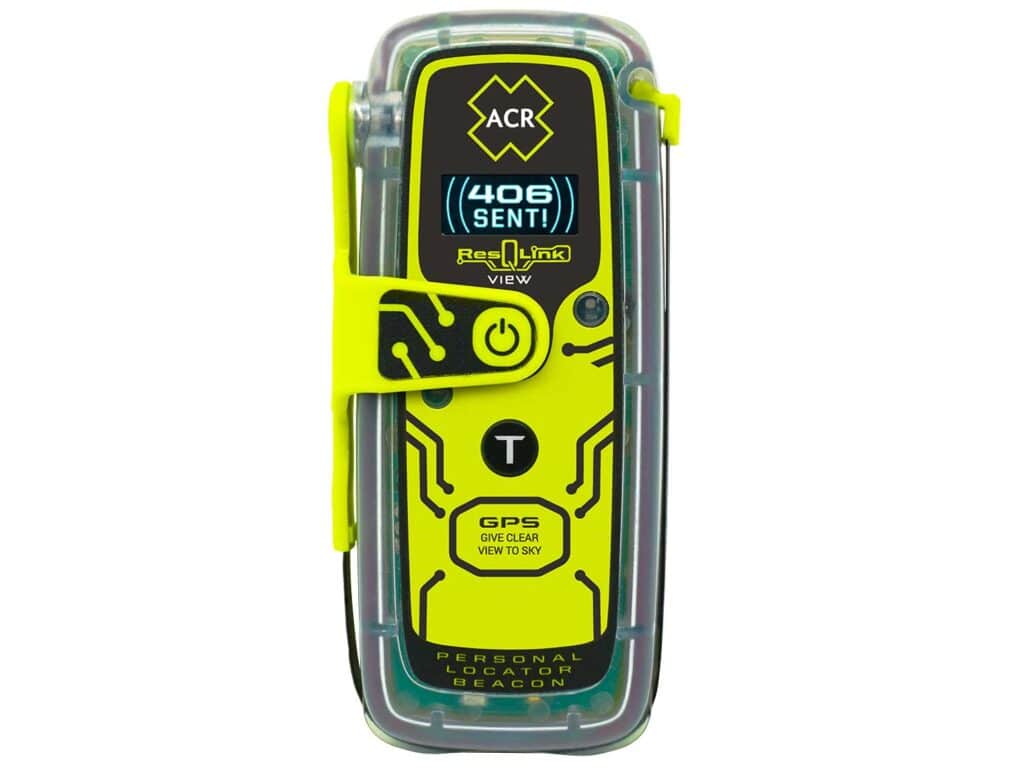
Personal locator beacons (PLBs) and emergency position-indicating radio beacons (EPIRBs) are tools that most boaters hope they will never have to use, but they can literally save your life. Able to instantly transmit a radio distress call via satellite, these high-tech devices work almost anywhere in the world and aren’t limited by cloud cover or extreme weather. Modern PLBs and EPIRBs equipped with built-in GPS are typically able to pinpoint your location down to a 100-meter radius in two to three minutes and instantly transmit it to rescue authorities.
Both PLBs and EPIRBs work by transmitting distress signals to a network of search and rescue satellites called Cospas-Sarsat. The network and beacons communicate on the 406 Mhz radio frequency reserved solely for distress calls worldwide, which is why you’ll sometimes hear them referred to as 406 Mhz beacons. When the satellites pick up a distress signal from a PLB or EPIRB, they relay the information to a global mission control center. Search and rescue authorities then quickly determine the location of the beacon and dispatch rescue teams to the area. Since the first Cospas-Sarsat satellites were launched in 1982, the system has aided in the rescue of more than 46,000 people.
Here’s how to decide which type of beacon is best for you and your type of boating, considerations and recommendations when purchasing, and the answers to some of the most commonly asked questions about emergency locator beacons.
Article at a Glance:
- Both personal locator beacons (PLBs) and emergency position-indicating radio beacons (EPIRBs) link to satellites overhead to quickly and easily send a distress signal, alerting local search-and-rescue (SAR) agencies.
- Personal locator beacons are designed to locate an individual, and should be attached to the user via clip, lanyard or strap.
- Emergency position-indicating radio beacons are registered to a specific person and vessel, and when activated send a distress signal with vital information and GPS position.
- All EPIRBs can be activated manually. Category 1 EPIRBs are also designed to activate automatically in the event a craft is sinking.
- Emergency beacons must be registered with the National Oceanic and Atmospheric Administration (or appropriate authority for non-U.S. boaters) and linked to an individual person or vessel.
- Some satellite communicators also include the ability to send a distress signal.
Types of Marine Emergency/Rescue Beacons
Deciding which type of emergency beacons is best for you depends on a variety of factors, including the size and type of vessel and the remoteness of your boating locations. Here’s a breakdown of the most popular emergency rescue beacons on the market, including PLBs, EPIRBs and satellite communicators with distress-call capability.
- Personal Locator Beacon (PLB): As the name implies, personal locator beacons are meant to locate an individual person. As such, ideally they should be attached to a life jacket or clothing or placed in a pocket. When activated, PLBs send a 406 Mhz satellite signal, which is forwarded to local search-and-rescue organizations along with the holder’s GPS coordinates and basic info such as name, address, emergency contacts and medical conditions. Batteries remain dormant until the device is activated, then typically transmit for 24 to 30 hours. Dormant batteries maintain a charge for up to five years. Some PLBs can transmit brief, pre-programmed nonemergency texts or emails to let friends or family know that the user is OK and provide an update on location. Extras? Consider a model with an LED strobe light to pinpoint your location.
- Emergency Position-Indicating Radio Beacon (EPIRB): Rather than a person, EPIRBs are registered to a vessel. When activated, EPIRBs broadcast a 406 MHz signal that is received and forwarded to the appropriate search-and-rescue organization, such as the Coast Guard or local law enforcement. That signal includes the boat’s name, description and GPS coordinates. Category 2 EPIRBs must be manually activated by someone aboard. Category 1 models can also be manually activated, but include a designated mounting bracket that releases the EPIRB once it senses 6 feet of water pressure. The EPIRB then floats to the surface and begins transmission automatically. Extras? Look for “smart” EPIRBs, which include a display noting the unit’s health and remaining battery life, offer activation prompts, and indicate that emergency messages have been received.
- Satellite Communicators: Designed primarily for satellite-based communication when outside normal cellphone range, satellite communicators wirelessly link to a smartphone to essentially turn your phone into a satellite phone. Most of these devices, including Garmin InReach, Spot X and ACR Bivy Stick, also include interactive SOS messaging in the event of an emergency. All require monthly service plans.
– INVEST TO IMPRESS – A boating course is a great way to gain confidence and boat-handling skills. A little practice now will make it look easy when everyone is watching. Safety Tip Provided by the U.S. Coast Guard
Read More: Marine Distress Calls Explained
Recommended PLBs & EPIRBs for Every Boater
PLBs, EPIRBs and satellite communicators are widely available, both online and in marine-/outdoor-specific retail shops. Below is a recommendation for each type of device, based on effectiveness, quality and price.
ACR ResQLink View
Rugged and compact, the buoyant ACR ResQLink offers multiple attachment points, including belt clip and lanyard. When activated, the ResQLink sends an SOS distress signal with GPS coordinates via the 406 MHz Cospas-Sarsat network, along with a 121.5 MHz homing signal to narrow down the search area for responding authorities. Includes an LED strobe light, as well as an infrared strobe light, to pinpoint the wearer’s precise location. $515; Amazon
- Type of beacon: PLB
- Best for: Solo boaters, crewmembers who run the risk of separation from EPIRB-equipped boat
- Price range: $415-$465 – Shop now
- Comparable products: Ocean Signal RescueMe PLB1, McMurdo FastFind 220 PLB
Why we like it: Includes GPS positioning, 406 MHz signal and 121.5 MHz homing capability, along with digital display, strobe and infrared strobe.
Ocean Signal RescueME EPIRB 3
Full-featured 406 MHz global rescue beacon includes AIS technology to allow more precise local information on current beacon position to speed rescue operations. The Return Link Service assures those in distress that their distress signal has been received. Near Field Communication capability allows smartphone monitoring of battery condition and operation. Includes a quick-release bracket, lanyard, and 10-year battery life. $809; West Marine
- Type of beacon: EPIRB
- Best for: Offshore/coastal/Great Lakes cruisers venturing outside cellphone range, boat crews with medical conditions, areas where assistance from other boaters is unlikely.
- Price range: $800 – Shop now
- Comparable products: ACR GlobalFix V4 406 GPS, McMurdo SmartFind G8 AIS, GME MT600G GPS
Why we like it: The RescueMe 3 includes AIS technology and a 121.5 MHz homing signal to speed response time and pinpoint your location for local rescuers, near-field monitoring to view battery status, and both visible and infrared strobe lights.
– UPGRADE YOUR RADIO – Digital Select Calling (DSC) allows you to transmit your precise location with the press of a button. Make sure your VHF radio has it, and don’t forget to get your MMSI number . It might just save your life. Safety Tip Provided by the U.S. Coast Guard
Garmin InReach Messenger
This small, lightweight, waterproof satellite communicator offers two-way text messaging outside cellphone coverage. It does not operate on the 406 MHz Cospas-Sarsat network and is not a substitute for a properly registered EPIRB or PLB. However, it does offer global text communications and can send an interactive SOS message in an emergency to Garmin’s monitoring and coordination center, which is staffed 24 hours a day, seven days a week. Rechargeable lithium battery provides up to 28 days of battery life. $299; Bass Pro Shop
- Type of beacon: Satellite Communicator
- Best for: Global two-way messaging, interactive SOS
- Price range: $300 – Shop now
- Comparable products: ACR Bivy Stick, Spot X, Iridium Go
Why we like it: Keeps users connected when beyond cell coverage with two-way messaging and offers interactive SOS messaging.
Considerations When Purchasing an Emergency Beacon
Various factors and included features can influence your choice of an emergency beacon. Here are several worth considering.
- Battery Life — Once activated, emergency beacons transmit continuously. EPIRBs typically have 48 hours of transmitting capacity, PLBs a minimum 24 hours, but individual models can vary. Batteries typically last about five years; most are now user-replaceable while others must be sent to the manufacturer or an authorized dealer for battery replacement. Look for indicators to check remaining battery capacity.
- Category — EPIRBs are available in two categories. Category 1 models can be activated manually, as well as automatically deploy if they are submerged—the latter being beneficial if a boat is sinking. Category 2 models feature only manual activation.
- Return Link Service — This feature offers peace of mind to those sending a distress call that the message has not only been received, but also that the beacon location has been identified.
- AIS Technology —Originally designed to prevent on-water collisions, Automatic Identification System technology sends and receives messages from other AIS-equipped vessels containing a boat’s identity and heading. Its incorporation into some EPIRBs allows an AIS distress alarm to be broadcast to vessels within range, and could potentially speed local rescue operations.
- Flotation — Whether Category 1 or Category 2, EPIRBs are required to float. The same does not apply to PLBs, although for obvious reasons, flotation is a valuable feature for boaters.
- Display — Built-in digital displays are offered on some models. They’re handy for checking battery status, and can give operating instructions, lat/lon positions and other useful information.
How To Rent an Emergency Beacon
Boaters who think they might only occasionally need an emergency beacon and wish to avoid the cost of purchasing one can make use of several rental programs, including those offered by BoatU.S. Foundation . GPS-enabled EPIRBs currently rent for as little as $10 per day, $65 per week or $220 per month; PLBs run $7 daily, $45 weekly and $150 monthly.
– CHECK THE WEATHER – The weather changes all the time. Always check the forecast and prepare for the worst case. Safety Tip Provided by the U.S. Coast Guard
Closing Remarks & FAQ:
Have additional questions about visual distress signals and their use? Find a list of frequently asked questions below.
- Do you need to register your PLB?
Yes, both new and used 406 MHz PLBs must be registered with the National Oceanic and Atmospheric Administration, by law. In addition, if you change address, phone number or purchase a new boat, the registration must be updated. Easy online registration is available at beaconregistration.noaa.gov/RGDB/index .
- Do you need to register your EPIRB?
Yes, both new and used 406 MHz EPIRBs must be registered with the National Oceanic and Atmospheric Administration, by law. In addition, if you change address, phone number or purchase a new boat, the registration must be updated. Easy online registration is available at beaconregistration.noaa.gov/RGDB/index .
- What size boat requires an EPIRB?
Commercial fishing vessels operating behind the 3-mile territorial sea line or 3 miles from the coastline of the Great Lakes must carry a 406 MHz EPIRB. A Category 1 EPIRB that will float free and automatically activate is required on vessels 36 feet and above; a manually activated Category 2 EPIRB is allowed on vessels less than 36 feet in length and on craft that have enough documented buoyancy to keep the flooded vessel afloat. In the United States, EPIRBs are not currently required on pleasure craft or recreational boats, but we strongly suggest one for those venturing out into larger waters ( uscg.mil ).
- Does a PLB satisfy the requirement to carry an EPIRB?
No, a PLB does not satisfy the requirement to carry an EPIRB on commercial vessels.
- What is the difference between Category 1 and 2 EPIRB?
Category 1 EPIRBs are bracket-mounted, and designed to automatically release and activate their emergency signal when submerged to a specific depth, typically 3 to 14 feet. For this reason, they must be mounted outside any cabin in order to be able to float freely away from a sinking vessel.
Category 2 EPIRBs must be manually activated. If installed in a fixed location aboard, they must be manually removed from any bracket for operation.
- Does an EPIRB have to be mounted?
Only Category 1 EPIRBs must be mounted because they utilize a bracket system that releases and activates the EPIRB when submerged to a specific depth. Category 2 EPIRBs may be mounted to ensure they are always readily available in a known location, but they must be removed and manually activated.
- What frequency are EPIRBs?
Modern EPIRBs and PLBs transmit a continuous signal to satellites via the 406 MHz frequency, reserved solely for distress calls worldwide. This signal allows the receiving authority to locate the beacon’s position, and is encoded with the user/vessel’s identity. Some beacons also broadcast a low-power 121.5 MHz homing signal to further locate a beacon’s position.
- What are the rules for PLBs and EPIRBs?
Both PLBs and EPIRBs must be registered with the National Authority of the country you live in. In the U.S., that’s the National Oceanic and Atmospheric Association and you can register free-of-charge at beaconregistration.noaa.gov . A dated registration sticker with a matching Unique Identification Number should also be affixed to the actual device itself. Testing can only be done of a PLB or EPIRB through a specific test position on the activation switch (if equipped) to avoid false alerts. Once activated, a PLB or an EPIRB must be left on until rescued or instructed to turn the unit off from the rescuing agency.
- Where can EPIRBs and PLBs be used?
EPIRBs are intended for maritime use only, but PLBs can also be used off the water by hikers, climbers, aviators and others.
- More: Boating Safety , coast guard , Gear , Safety Gear , Water Sports Foundation

Boating’s Deals of the Week

What Are the Best Boat Porta Potty Toilets?
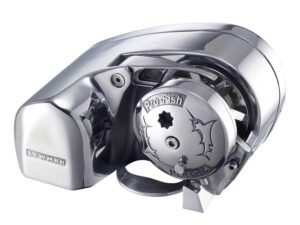
Ultimate Boat Anchor Winch Buyers’ Guide
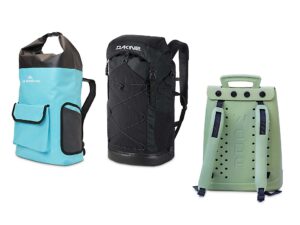
Three Great Backpacks for Boaters
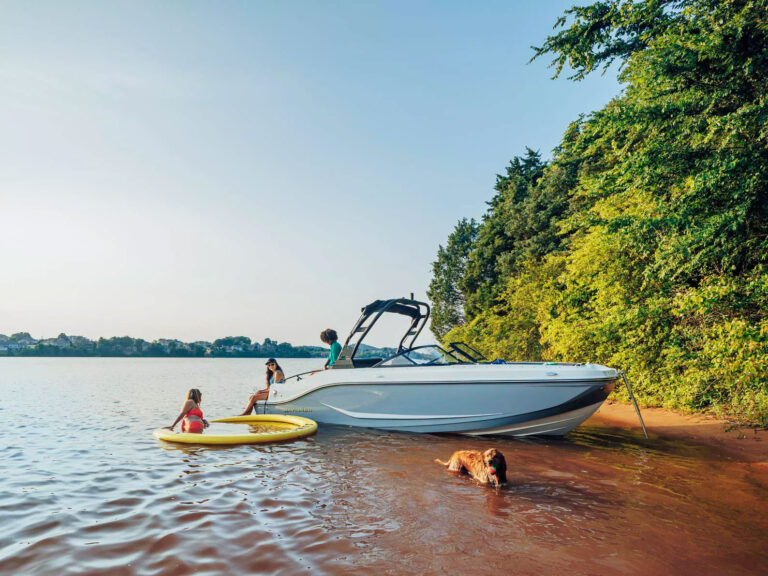
Bayliner 2024 D Series Deckboats Debut
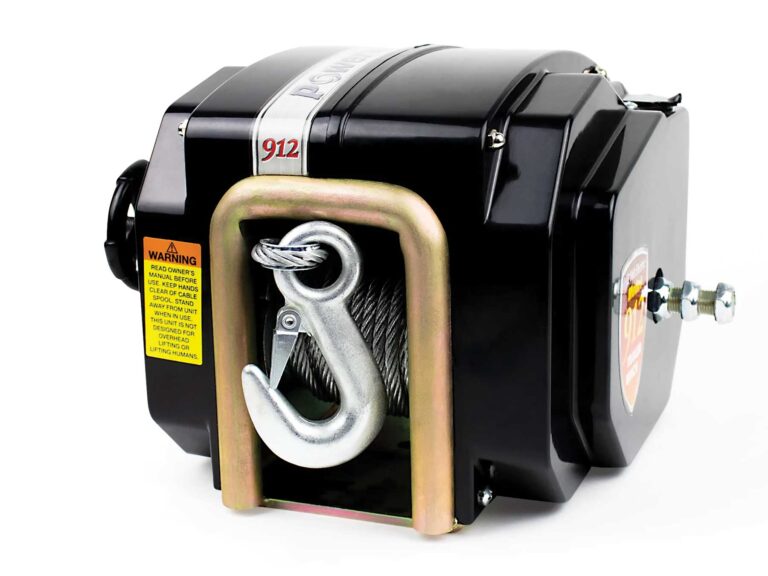
How to Choose a Trailer Winch

Is Your Trailer Right for Your Boat?
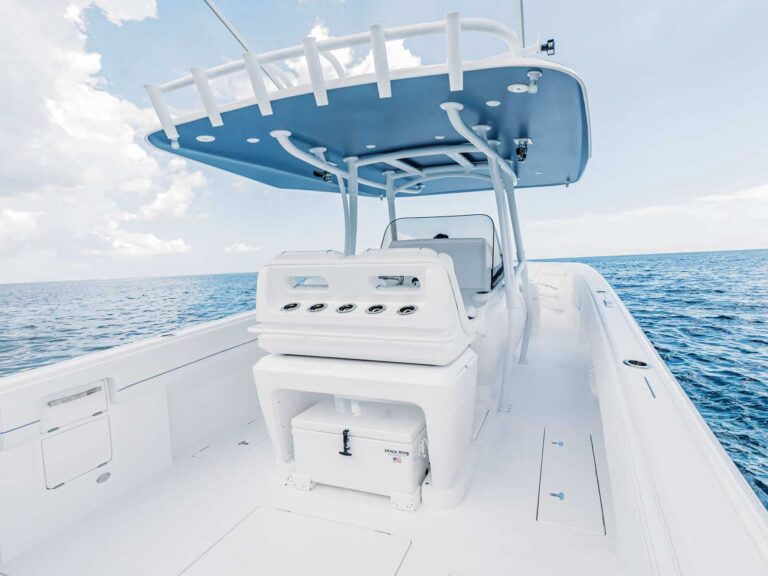
Best Non Skid Boat Deck Paint

- Digital Edition
- Customer Service
- Privacy Policy
- Terms of Use
- Cruising World
- Sailing World
- Salt Water Sportsman
- Sport Fishing
- Wakeboarding
Many products featured on this site were editorially chosen. Boating may receive financial compensation for products purchased through this site.
Copyright © 2024 Boating Firecrown . All rights reserved. Reproduction in whole or in part without permission is prohibited.
- Pontoon Boats
- Personal Watercraft
- nauticalknowhow
- Nautical Knots
- Tools and Calculators
The Best EPIRB for 2024
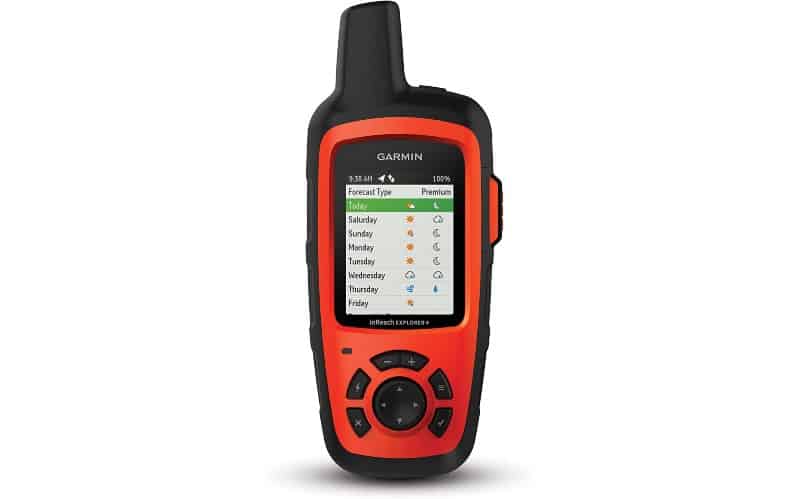
Garmin inReach Explorer
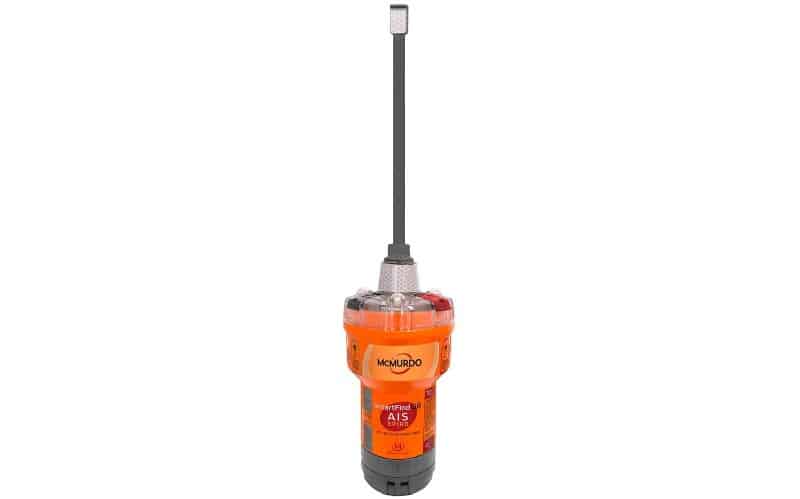
McMurdo Smartfind
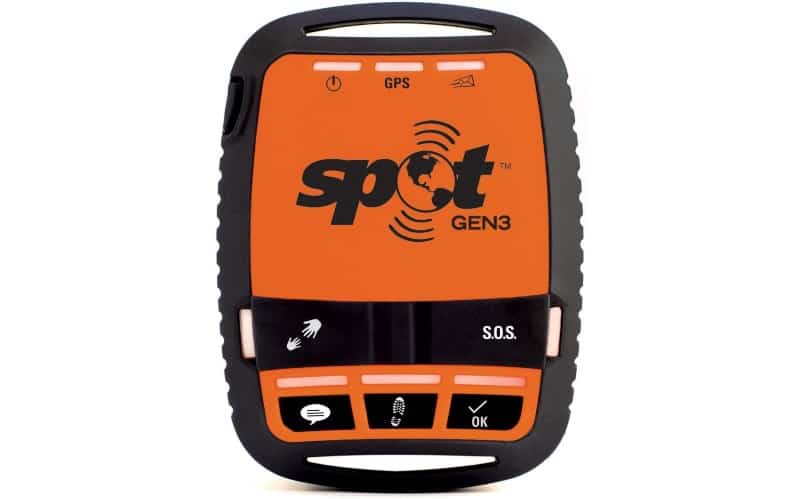
Spot 3 Satellite GPS
Boating safety is key to being able to enjoy your time on the water. Any sailor needs to have the proper emergency gear on board before you head out. This includes the obvious things, like personal flotation devices. But technology can also help make your sailing smooth. You want a good quality VHF radio on board. Likewise, a solid GPS is invaluable. But along with that, an Emergency Position Indicating Radio Beacon is also essential.
An EPIRB will help search and rescue find you in the event of an emergency. No one wants things to go wrong. But you need to be prepared when they do. A good quality EPIRB can track your location anywhere in the world. Some even offer the ability to text with others. Some can give you weather data and charts.
Choosing the right EPIRB means factoring in your budget and how you boat. If you’re on a landlocked lake, you may not need some of the more elaborate features. But if you’re on a vessel, it’s always good to have a way to be found in an emergency.
Let’s check out some of the best EPIRB units on the market. After, we’ll look into the difference between EPIRB and GPRIB. Also some features you want to consider.
Garmin is the brand to beat when it comes to EPIRB. This is the Cadillac of emergency position beacons. They make a wide range of devices to handle any boater’s needs. They also have you covered when you need car GPS as well. Hands down, their best model is the InReach Explorer.
The InReach offers complete iridium satellite coverage. Anywhere on Earth, you’ll be able to have two-way communication via text messaging. It also functions as a standard GPS as well. The body of the Explorer is durable and can stand up to some abuse. It’s fully waterproof, but also lightweight.
The technology Garmin uses is what makes it a standout. For instance, there’s a share function built in. That means anyone with a linked device can also see your position. Family or friends on shore can track your trip if need be. In terms of safety, that makes this next level useful for a thorough float plan . In the event of an emergency out on the water, the U.S. Coast Guard can track you down easily and quickly.
Speaking of, it also features an SOS button. This distress alert allows you to transmit your location and a pre-set emergency message. There’s also a weather forecast function to help you track storms.
Garmin offers unlimited cloud storage with purchase. That means you can plan your whole trip and access it over the device anytime, anywhere.
Buy on Amazon →
Garmin InReach Mini
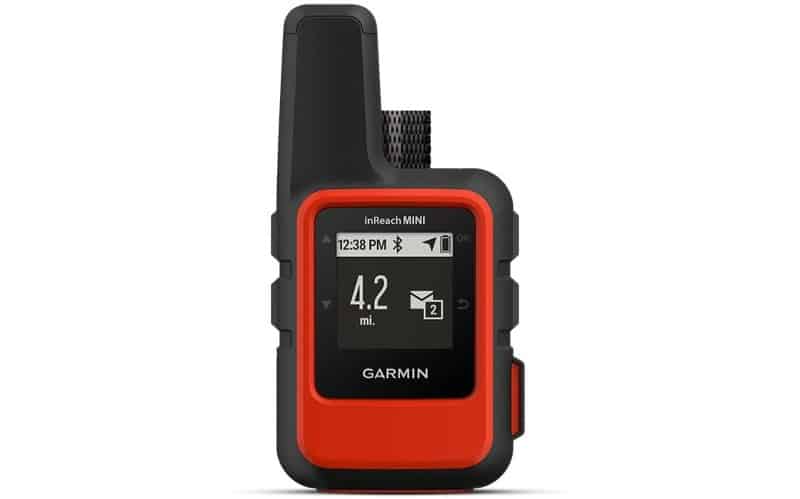
The Garmin InReach Explorer is not a cheap device by any means. If you’re not looking for such a big investment in an EPRIB, there is a solution. The Garmin InReach Mini is their pared down version. It’s more affordable and still offers a lot of great features.
Just like its larger cousin, the Mini offers you complete iridium satellite coverage. That means you can have two-way text communication anywhere in the world. If your cell phone is dead because you’re in the middle of nowhere, the Mini will still have you covered.
In addition to communication, the Mini can do much more. It will give you access to charts, weather reports, and more with the Garmin Earthmate App. All you need to do is pair it with a compatible device like your smart phone.
In an emergency, the Mini will also broadcast an SOS signal along with a message to get you help as soon as possible.
The McMurdo Smartfind activates automatically once it comes in contact with water. It also features manual function as well. It’s the first EPIRB in the world to include AIS, or automatic identification system. All AIS-equipped vessels in range will pick up the signal. That increases the likelihood of being found in an emergency. All told, the McMurdo offers 406MHz, 121.5MHz, AIS, and GPS.
The battery life of the McMurdo is second to none. It features 10 years of life. The unit is also designed with a powerful strobe light.
The technology used by McMurdo is very similar to MOB beacons. Those are the man overboard beacons that help track people in the water. When you want to make sure you have some of the best coverage available, McMurdo is a great choice. The company even offers a 5 year warranty.
As good as Garmin products are, they can set you back a few dollars. You may not be interested in spending so much if you have a small vessel. Likewise, if you don’t boat that often. But if you still want the peace of mind that an EPIRB offers, Spot 3 is a great choice.
The Spot 3 Satellite GPS offers up great service at a reasonable price. Push button SOS sends out an emergency signal right away. Your location will be GPS tracked. This way, emergency services can track you. It also features a handful of ways for your family and friends to follow your progress. You can upload your contacts so they can see your location on Google Maps. There’s also a check in feature. This allows you to send a pre-programmed message to friends and family.
The body of the Spot Three is lightweight but durable. If you drop this on deck, you don’t need to worry about it breaking. And, of course, it’s also waterproof.
Ocean Signal Rescue Me EPIRB
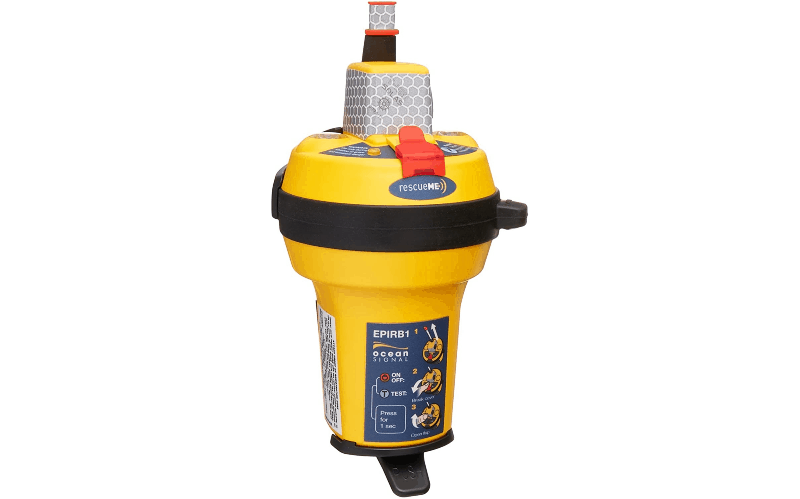
With 10 years of battery life, the Ocean Signal Rescue Me can offer you peace of mind for a long time to come. This is also a great choice when space is a consideration. If you have a small vessel and don’t want to devote a lot of space to an EPIRB, this is your answer.
Coming in at 30% smaller than your average EPIRBs, Ocean Signal is all about space saving. It even has a retractable antenna. Despite its size, it’s just as powerful and reliable as the big boys.
Ocean Signal lists the dimensions of the Rescue Me as 7 inches by 3.9 inches by 3.5 inches. That makes it about two pencils tall. You can see how storage on most boats would be easy.
It features two bright strobe lights. The battery pack is reliable for up to 48 hours of continued use once activated. There’s also a quick release bracket to pull it from a wall. It will be registered in the US at point of purchase. After that, the company will register it anywhere on Earth for you if you want.
ACR GlobalFix Pro
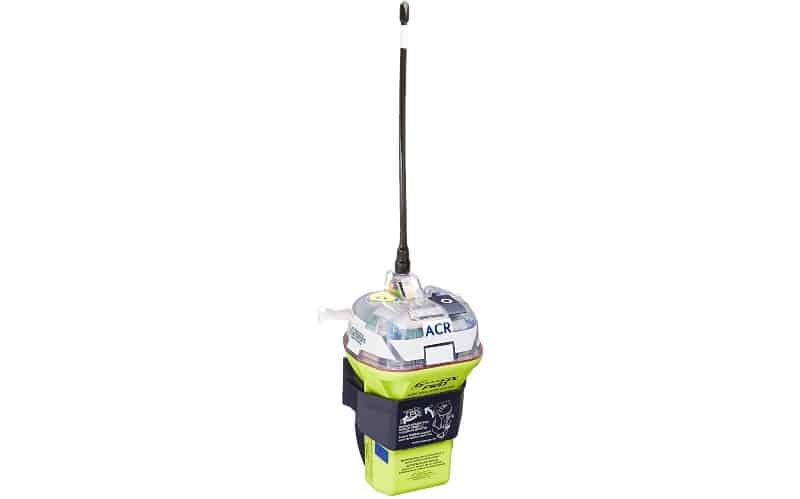
When it comes to emergency features, the ACR GlobalFix iPro is top notch. It acquires a GPS signal automatically and is accurate to within 100 meters. The signal is sent out at 406 MHz to increase accuracy above and beyond many other devices. To further direct crews to your location it offers additional features as well. An LED strobe light offers a powerful visual indicator. Thanks to the physical design, even in water, it floats upright. The light will always be visible. There’s also a homing beacon.
If the GlobalFix Pro ends up in the water, it will automatically turn on. It can also be turned on manually. And it features a test function. This lets you confirm whether it’s working properly. The battery has a lifespan of about five years when it’s not in use, so it’s reliable. Once it has been activated it can transmit a signal for as long as 48 hours.
One of the best features of the Globalfix is the replacement guarantee. If you ever need to use the device, ACR will replace it with a new one afterward.
Things To Remember
Obviously not every EPIRB is created equally. Understanding the features will help you pick the best emergency beacon for you.
What is an EPIRB Anyway?
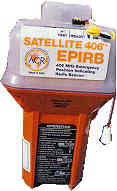
An Emergency Position Indicating Radio Beacon is a small, rugged, battery operated device. In its basic form, it is simply a transmitter. Like all emergency beacons, EPIRBS transmit a signal that can be tracked. They are monitored by satellite so your position can be tracked worldwide.
When you first get an EPIRB you need to register it. This ensures that when it is activated, you can be properly identified. The signal sent from a registered EPIRB includes essential personal details. Your name, address, phone number, vessel description, and an emergency contact are included.
Signals from EPIRBs will be transmitted on the Cospas Sarsat. This is a global satellite network used by sailors for search and rescue. 45 nations and agencies around the world respond to distress signals on this network. This includes the U.S. Coast Guard.
What is a GPIRB?
You’ll see the acronym GPIRB used alongside EPIRB very often. GPIRB stands for Global Position Indicating Radio Beacon. Some of the EPIRBS we listed here, like the Garmin, are technically GPIRBs.
A GPIRB has a built in GPS and 406MHz EPIRB technology together. This makes the accuracy of the device much greater. You may know from experience that satellite tracking isn’t always super precise. For instance, a food delivery service’s tracking software. It will tell you the driver is three blocks away when he’s at your door. Your car GPS may also offer vague results sometimes.
GPIRB is able to narrow down your location very well. Search and rescue teams will have a much smaller area to search as a result. It’s likely they will visually pinpoint you right away if you have a GPIRB on board.
Essentially, a GPIRB is a life insurance policy on the water. It removes the chance of being lost at sea. If you routinely boat in large bodies of water, from the ocean to the Great Lakes, this is very useful.
How are GPIRB and EPIRB Different?
If both send signals to satellites, you may wonder how GPIRB and EPIRB are different. It’s in the way signals are sent and the time it takes to track. EPIRB has to essentially ping a satellite. Calculations based on Doppler shift in the distress signal determine where it is. This can take time. Maybe not a lot of time, but in a rescue situation every second counts.
GPIRB is able to locate itself with GPS and broadcast that location. It cuts out that calculation time. The accurate location fix is nearly instantaneous. Rescue teams will be able to track your location much more easily as a result.
What is a Personal Locator Beacon?

In researching EPIRB devices you may also discover PLB. A Personal Locator Beacon is almost exactly the same as an EPIRB. The main difference is that it’s intended for land use. A sailor could certainly use their device as a PLB. Likewise, a PLB could function on a boat. Both use global satellite networks to pinpoint your location. Personal locator beacons are still different EPIRBs, though.
Ideally, you won’t want to use a PLB on a boat if you can avoid it. Again, not that the PLB won’t work on a boat, because it will. A PLB isn’t set up for nautical use, however. You don’t get the fringe benefits with a PLB, like access to NOAA charts. Also, a PLB is unlikely to be waterproof.
Typically, a PLB would be used by hikers and mountain climbers. Anyone who risks being lost or endangered away from civilization.
These devices also have a long lasting lithium battery. They can go for years without needing replacement. The downside is you can’t typically replace the battery yourself.
EPIRB Features You Need
As we have said, not every EPIRB is created equally. You can get some cheap, off brand car GPS units that will save you some money. You don’t want to do the same thing with an EPIRB. If this device is the difference between surviving at sea and not, make sure you pick the right one.
Battery Life: Many EPIRB units have remarkable battery life. Lithium battery packs or other non-hazmat-batteries are essential. Check to see how the battery can be replaced. Some units will allow you a free replacement once you have used the EPIRBs. Some companies will allow you to send the unit back for battery replacement. Some have no offers at all. When the battery dies, you simply need to buy a new unit.
Since the price of an EPIRB can range from $200 to over $700, you want to know how the battery works.
GPS: GPRIB is simply better than EPIRB alone. When an EPIRB is triangulating your location, it can take time. Sometimes as much as an hour. In severe weather you can drift a good distance in that time. So while it’s still great at narrowing your location, it’s not the best. Look for built in GPS to help improve reliability and response time.
You need a quick notification time in order for your device to be effective. Compare times and choose the fastest you can find. The quicker search and rescue services can determine your location, the quicker you get saved.
Construction: As we saw with PLB, not every unit is waterproof. If you’re using an EPIRB, it’s because things have gone bad. You need a unit that is not just fully waterproof but rugged. It’s going to get beat around. You won’t have time to protect the unit from bumps, so make sure it’s proven tough.
A lighter unit is going to be easier to pack and store. Also easier to manage if you end up in the water. Most units float, but you still need to keep track of yours. Things like a tangle-proof lanyard are great features.
Additional Features: The very basic features of an EPIRB will get you rescued. But it never hurts to have some extras on board. Devices that offer the ability for two-way communication are the best of the best. Or ones that can provide AIS signals to other vessels nearby.
At the very least, consider a device with a homing beacon. Also a high powered led strobe light. When you’re in the water in a storm, these can make those final seconds of search and rescue easier.
Extra features, like access to weather forecasts and charts, can cost more money. You’ll have to determine based on how you boat if these are vital for you.
My grandfather first took me fishing when I was too young to actually hold up a rod on my own. As an avid camper, hiker, and nature enthusiast I'm always looking for a new adventure.
Categories : Boats , nauticalknowhow
Leave a Reply Cancel reply
Your email address will not be published. Required fields are marked *
Save my name, email, and website in this browser for the next time I comment.
More in Boats

What Is A Gunwale?

131 of the Best Hawaiian Boat Names

167 Patriotic Boat Names

The 138 Best Boat Names for Dog Lovers

The People’s Poncho Review and Ratings

Oru Lake Kayak Review

About Boatsafe
Established in 1998, BoatSafe is your independent guide into the world of boating, fishing, and watersports. We provide expert insights and detailed guides to help you find products tailored to your needs and budget.
Contact Boatsafe
- Address: 4021 West Walnut Street. Rogers, AR 72756
- Phone: (479)339-4795
- Email: [email protected]
Site Navigation
- How We Test
- Corrections Policy
- Privacy Policy
- Terms & Conditions
- Editorial Policy
- Affiliate Disclosure
Our Reviews

All content is © Copyright 2024. All rights reserved.
The 5 Best EPIRBs for Sailing & Boating

Table of Contents
“As an Amazon Associate I earn from qualifying purchases at no additional cost to you”
If the worst comes to happen at sea, you need to be prepared. EPIRBs stand at the top of the list for essential safety devices for serious sailing.
What are EPIRBs, what is the benefit of having one, how much do they cost and what are the things you should look out for when choosing one? We’ll be answering all these questions and several others you might have in this article.
| Product Image | Product Name | Key Features | Star Rating | Buy Now |
| ACR GlobalFix V4 Cat 2 EPIRB | ||||
| ACR GlobalFix V4 Cat 1 EPIRB | ||||
| Ocean Signal Rescue ME EPIRB1-7025-01540 | ||||
| GLOBALFIX V4 EPIRB Survival Kit | ||||
| ACR ResQKit PRO Survival Kit |
We’re going to dive into details on these top 5 EPIRB’s and cover some essential points on the use of them. So let’s dive in!
What is an EPIRB?
The EPIRB, known fully as the Emergency Positioning Indicating Radio Beacon, is a device placed on board sailing and boating vessels to notify search and rescue services (SAR) in times of emergency at sea. It performs this function by transmitting coded radio signals to SAR satellites worldwide through the multinational Cospas Sarsat network for free .
After the closest SAR satellite receives the 406 MHz distress frequency signal via the satellite and earth station, the signal is then sent to a receiving station before it finally gets to a control center.
It will help if you are also aware that this rugged battery-operated transmitting device can be categorized on its release mechanism and operating band.
Types of EPIRBs according to their Release Mechanism
Category I: EPIRBs in this category are automatically activated at a water depth of 1-4meters. This means when the vessel begins to sink at the above-stated depth, the buoyant EPIRB will be released from its bracket, and signal transmission is automatically activated.
Category II: EPIRBs here are manually activated, and you’ll need to keep them in a very accessible location onboard the vessel.
Types Of EPIRBs According to Their Frequency Band
Several EPIRBs are also programmed to transmit signals to specific bands
The COSPAS-SARSAT System: This system consists of satellites established by Russia, the US, France, and Canada. They can locate and receive signals from EPIRBs transmitting in the 406.025MHz, 243MHz, and 121.5MHz bands.
INMARSAT E: These EPIRBs can transmit signals only to satellites with 1.6GHz. They are perfect for sea areas in the A1, A2, and A3 regions.
VHF CH 70: Some EPIRBs connect with the 156.525 MHz band only, making them perfect for sea area A1 only.
ACR GlobalFix V4 Cat 2 EPIRB and ACR GlobalFix V4 Cat 1 EPIRB
Starting, we have the ACR GlobalFix V4 Cat 2 and ACR GlobalFix V4 Cat 1 EPIRB. These two products are quite similar as they are produced by the same manufacturers and are the same model. However, while the Cat 2 is manual, Cat 1 is automatic.

This implies that to activate Cat 2, you’ll need to remove the device from the mounting case and activate the distress signal yourself. With Cat 1, however, the EPIRB is automatically released from the mounting case whenever the bracket gets submerged to a depth of 4-14feet in water.

This automatic release is made possible through the presence of a hydrostatic release unit which you’ll need to replace every 2years. Also, note that the difference in how the distress signal is activated in these two devices translates to an increase in the cost of the Cat 1 EPIRB model.
Apart from the difference in the mode of activation, however, the ACR GlobalFix V4 Cat 1 and 2 are similar in every other way. They both are programmed for use only in the US and have a 66 channel GPS feature included to help the SAR pinpoint your exact location. The ACR GlobalFix broadcasts via 406MHz, while the 121.5MHz guides rescuers to your exact location.
With these devices, you’ll also enjoy a battery life of 10 years and, once activated, the beacon will continue sending distress signals for 48hrs.
Finally, you’ll be glad to see that you don’t need to worry about sending false distress signals as both models feature keypad casing.
Key Features
- The beacons can be manually or automatically activated
- It features a 66 channel GPS
- Keypad casing that prevents accidental activation in both models
Ocean Signal Rescue ME EPIRB1-7025-01540
Next on the list is the Ocean Signal Rescue ME, also programmed for US registration.
Well, you’ve seen what the ACR GlobalFix offers, so what are the similarities, and in what way is the Ocean Signal better, if there are any?

For one, like the ACR GlobalFix V4 Cat 1, this device is automatically activated when submerged in 4-12 feet of water. It also comes with the 66 channel GPS positioning that guarantees the SAR’s accurate pinpointing of your distress signal.
In addition to this, you can also be sure that your EPIRB will stay on for 48hours once activated, and like the ACR GlobalFix V4, the battery has a life expectancy of 10 years.
However, this device is much smaller and lighter than the GlobalFix. It weighs only 1.5lbs, unlike the GlobalFix that weighs 3.29lbs, hence the nickname, “small but mighty”.
You’ll also be able to retract the antenna of the Ocean Signal. This saves space and ensures that the antenna lasts long, amongst other things.
- The Ocean Signal Rescue ME battery life is rated 7years
- This product is 33% smaller than several other EPIRBs in the market
GLOBALFIX V4 EPIRB Survival Kit
Moving on, we have the GlobalFix V4 survival kit. This device is a tad bit different from previously reviewed EPIRBs as it comes pre-packed with loads of other accessories that help make rescue operations easier and faster.

Like its name, this is a true survival kit, and you’ll see a signal mirror that allows you to signal for help in times of distress. You’ll also find that this kit contains a life jacket, strobe lights, and even a USCG whistle, all of which come together to aid the search and rescue team in locating and rescue operations.
Moving away from the accessories included in the GlobalFix V4 survival kit, you’ll find that this kit features a 10year replaceable battery. It also requires manual activation to successfully send out distress signals during emergencies, making it a Cat II EPIRB.
- The RapidDitch express bag can float 15lbs of gear
- It needs to be manually activated
- The package includes six components
ACR ResQKit PRO Survival Kit
Last but not least is the ACR ResQKit Pro survival kit. This is yet another EPIRB that packs a lot of pre-included accessories to make rescue operations easier. However, the ACR ResQKit gives you three more accessories: the distress flag, a personal locator beacon, and the E-flare.

All accessories included in this kit are USCG approved, and with them on board, you can do without the traditional pyrotechnic flares onboard. The ResQflare delivers 360-degree visibility over a distance of 6 miles and meets the USCG 75CD peak fixed light intensity requirement, which must last for a period of over 20hours.
Also, the Firefly PRO Waterbug and HemiLight3 LED Strobe lights will make rescue operations at night easy, while during the day, the signal mirror and distress flag are the way to go.
- The package includes eight components.
- The ResQFlare is USCG approved as a nighttime distress signal
- The distress flag is USCG approved as a daytime distress signal
Why Should You Have an EPIRB Onboard?
Wondering why you should have an EPIRB on board your vessel? Well, Among the many reasons why an EPIRB is a must-have on the boat while sailing, some of the most important reasons include the fact that this distress beacon boasts a longer battery life than PLBs; actually, about 24hrs longer.
Additionally, you have the freedom to pick either automatically activated or manually activated options. Finally, besides being quite durable and rugged, you’ll also find that these devices can float and won’t get submerged with the boat.
What Are the Critical Features You Should Look for In An EPIRB?
Choosing an EPIRB doesn’t have to be a difficult process. Here are some essential features you must ensure are present in your EPIRB device before you go ahead to purchase it.
Long Battery Life
First on the list of things to look out for when choosing an EPIRB is the long battery life. With long battery life, you can ensure that your EPIRB will continue transmitting the signal until the signal gets to a SAR. When choosing EPIRB devices, you also want to ensure that the batteries are replaceable so that you wouldn’t need to change the entire unit when the battery dies.
Durable Construction
Another critical thing to consider is the device’s construction. The device needs to be rugged, waterproof, and lightweight. It should take a beating without any adverse effect on its functionality.

GPS feature
EPIRBs with the GPS feature are known as GPRIBs. With this feature, you don’t need to worry about the distress beacon having issues pinpointing your exact location. Unlike EPIRBs that triangulate and narrow down your location, these devices can decipher the exact place you are.
Other features to Lookout For
In addition to the above features, some other crucial features to look out for when choosing an EPRIB include auto-activation when immersed in water. Sailing tragedies are emergencies. If you can’t activate the beacon manually, you need to be sure that the beacon can send distress signals itself.
Other nice-to-have features include a two-way communication feature and a honing beacon that will make search and rescue operations in low light conditions a lot easier.
What Should You Expect to Pay for A Good EPIRB?
Unlike before, when you’ll budget around $1000 to get a good EPIRB, these days, with as low as $200, you can purchase a good EPIRB device. However, this is just the base cost, and you should be ready to spend as much as $350-$500 if you desire access to features like weather forecasts and charts, GPS features, and other extra features.
Also, note that you will be required to register your EPIRB device before you can begin using it on your boat. Registration is free and can be done online.
FAQs on EPIRBs
Q: What Is the Difference Between A GPS EPIRB And a Standard EPIRB?
A: GPS EPIRBs are slightly different from the conventional or standard EPIRBs you might be familiar with. These GPS EPIRBs have a built-in GPS tracking system that guarantees precision when locating you during search and rescue operations.
With a GPS built into the EPIRB, you can be sure the inherent delay that occurs due to the satellite trying to determine the beacon’s location will be eliminated, hence increasing your chances of being rescued early.
Also, these GPS EPIRBs cost about a few bucks more than the standard EPIRBs, so we recommend you opt for them when shopping for EPIRBs. You can’t even buy standard ones in the US anymore, as they are banned, not to mention that some EPIRB manufacturers have discontinued the manufacture of standard ones.
Q: What Is the Normal Battery Life of an EPIRB?
A: When purchasing an EPIRB, you must check and ensure that the device can transmit for a minimum of 48 hours before the battery runs out of power. Many EPIRB manufacturers guarantee that the battery in their devices has a life expectancy of 5-10years. After which, they cannot guarantee the recommended minimum 48hours transmission time required once an EPIRB is activated.
Q: Do You Have to Pay a Subscription Fee to Have an Active EPIRB?
A: Activating your EPIRB device is usually free, and you would not need to pay a subscription fee to keep it active. After purchasing your EPIRB, all you need to do is register the EPIRB with your local authority.
After you do this, you don’t need to pay a renewal fee. However, you need to note that if you change any information on your registration, you need to update the 406-registration beacon. Selling your beacon also means you must notify the local authorities and ensure that the new owner registers the beacon using their info.
Q: How Reliable Are EPIRBs & Are They Likely to Fail?
A: Although EPIRBs are one of the most reliable pieces of safety equipment you’ll need onboard your vessel while sailing, like all devices, EPIRBs are not 100% foolproof. For one reason or the other, your EPIRB might fail. To prevent this and always stay one step ahead, it is recommended that you have routine maintenance of your EPIRB.
The NOAA and coast guards recommend monthly maintenance and testing since this device will be exposed to harsh weather conditions. Also, we emphasize ensuring that your EPIRB is properly registered, well maintained, and positioned properly on the vessel.
Q: Is It a Good Idea to Buy a Second-Hand EPIRB?
A: There are no laws that forbid buying a second-hand EPIRB; however, we recommend that you check and confirm that the EPIRB is in top working condition.
Also, ensure that the EPIRB battery isn’t at its limit. The battery should still have some good years left in it. And if it is at its limit, ensure that the battery is replaceable. No point in buying a second-hand EPIRB with a non-replaceable battery.
Lastly, the owner must contact the authorities to notify them that the beacon has been sold and then change ownership. After this, as the new owner, you will be required to update the details and register the EPIRB in your name.
Q: What Is the Difference Between A PLB And An EPIRB?
A: PLB stands for Personal Locator Beacon, and like EPIRBs, they are used to send coded 406MHz distress signals through the Cosapass-Sartat global satellite system. However, there are some differences between the two.
The principal difference is that, while an EPIRB is registered to a boat, the PLB is registered to an individual. Also, PLBs are handheld, and there is a greater likelihood of accidental activation, so they can only be manually activated and are suitable for use on land and water.
Additionally, PLBs are smaller in size, have a smaller battery capacity which means instead of 48 hours; they can only transmit for a maximum of 24hours. The batteries have a life expectancy of 6years and not the 10 years touted by EPIRBs.
Finally, we’ve also found that not all PLBs are designed to be floatable. They may, however, come in floatable sleeves, which they must be carried in.
Q: Do You Need to Register Your EPIRB?
A: Registering your EPIRB with your local authorities after purchasing it is crucial to your survival. Without registering your EPIRB, even if it is properly maintained, well-positioned, and fully functional, if disaster strikes, the beacon will transmit the distress signal to the necessary authorities, but there might be a delay in responding and helping you at the time. Also, by registering your beacon, the SAR will reach out to your emergency contacts.
WindyHQ has more information on EPIRBs, how they work, how to use one, and the satellites they connect to. So after going through the review on the best EPIRBs for boats, do well to check it out.

Bill is an ISA Sailing & Powerboating Instructor in Ireland. He writes about all things sailing.
Related Articles that might be of interest to you:

How to Rig a Sunfish Sailboat
“As an Amazon Associate I earn from qualifying purchases at no additional cost to you” How to Rig a Sunfish Sailboat The Sunfish is arguably the most popular sailboat on the planet. Its popularity is characterized by its inexpensive price, easy portability (probably the only car-toppable sailboat), and easy

What Must you Do When Anchoring at Night? – Tips and Rules
“As an Amazon Associate I earn from qualifying purchases at no additional cost to you” Let’s face it, in comparison to anchoring in the day, anchoring at night is no Child’s play. There are many variables in play here, and you’ll have to stay on top of every one of

How to Drain Gas from an Inboard Boat
“As an Amazon Associate I earn from qualifying purchases at no additional cost to you” Draining gas from your boat is essential in maintaining optimal performance especially in the offseason period when it is not in use. Many boat owners ensure their tanks are empty before winter to avoid residue
Leave a Comment Cancel Reply
Your email address will not be published. Required fields are marked *
- Techniques & Guides
- Yacht Equipment
- Personal Gear
Made by Dancing Data.
Disclosure . Terms and Conditions . Privacy Policy
- Hiking Shoes
- Hiking Boots
- Hiking Sandals
- Trail Runners
- Base layers
- Hiking Shirts
- Fleece Jackets
- Softshell Jackets
- Rain jackets
- Down Jackets
- Hiking Pants
- Hiking Shorts
- Base Layers
- Rain Jackets
- Hiking Bras
- Baby Carriers
- Cookware Sets
- Water Filters
- Water Purifiers
- Sleeping Bags
- Sleeping Pads
- Hiking Poles
- GPS Devices
- Solar Chargers
- Dive Regulators
- Dive Computers
- Dive Watches
- Dive Wetsuits
- Dive Gloves
- Dive Lights
- Dive Knives
- Spearfishing Wetsuits
- Spearfishing Masks
- Spearfishing Fins
- Spearfishing Watches
- Freediving Wetsuits
- Freediving Masks
- Freediving Fins
- Freediving Watches
- Sit On Top Kayaks
- Inflatable Kayaks
- Fishing Kayaks
- Tandem Kayaks
- Touring Kayaks
- Kayak Paddles
- Kayak Seats
- Kayak Roof Racks
- Kayak Carts
- Stand Up Paddle Boards
- Touring SUPs
- Inflatable SUPs
- Fishing SUPs
- SUPs For Yoga
- SUPs For Surfing
- SUP Paddles
- Climbing Boots
- Belay Devices
- Climbing Shoes
- Women's Climbing Shoes
- Bouldering Shoes
- Approach Shoes
- Climbing Pants
- Bouldering Pants
- Mountain Bikes for Men
- Mountain Bikes for Women
- MTB Handlebars
- Bike Saddles
- Bike Computers
- Bike Lights
- MTB Jackets
- Bike Helmets
- Bike Packing Gear
- Fat Biking Gear
- Ski Bindings
- Ski Helmets
- Ski Goggles
- Ski Jackets
- Snowboarding Bindings
- Snowboarding Boots
- Snowboard Helmets
- Snowboard Goggles
- Snowboard Pants
- Snowboard Jackets
- Snowshoe Poles
- Avalanche Beacons
- Avalanche Probes
- Avalanche Shovels
- Ski Backpacks
- Surfboards For Beginners
- Surfboards For Kids
- Surfboard For Small Waves
- Soft Top Surfboards
- Foam Surfboards
- Body Boards
- Boogie Boards
- Kiteboarding Kites
- Kitesurfing Boards
- Kiteboarding Harnesses
- Surfing Wetsuits
- Men's Rash Guards
- Women's Rash Guards
- Board Leashes
- DLSR Travel Cameras
- Mirrorles Travel Cameras
- Point and Shoot Travel Cameras
- Fuji Travel Lenses
- Nikon Travel Lenses
- Tripods for Travel
- DLSR Landscape Cameras
- Mirrorles Landscape Cameras
- Point and Shoot Landscape Cameras
- Fuji Landscape Lenses
- Nikon Landcape Lenses
- Canon Landcape Lenses
- Tripods for Landscape Photo
- Wildlife Cameras
- Wildlife Lenses
- Wildlife Tripods
- Wildlife Monopods
- Birdlife Cameras
- Birdlife Lenses
- Surfboards For Small Waves
Best EPIRBs of 2024
Emergency Position Indicating Radio Beacons, also known as EPIRBs, are small radio transmitters that are connected to a global emergency communications network that helps search and rescue groups to locate you in the event of an emergency. These devices are especially necessary on ocean-faring sailboats where currents, tides, and weather can make for unpredictable and sometimes dangerous conditions. Whether you’re an experienced sailor who’s just looking for the latest, most up-to-date gear or if you’re newer to the sport and need to build your gear closet, we’ve put together this guide to help you choose the best EPIRB for you and your vessel. Included in this guide is also some key vocabulary and information to help you make the most informed purchase possible. Check it out, and see you out there, sailor!
For more of our top sailing gear recommendations, check out the Best Life Jackets for Sailing .
Quick Answer - The Best EPIRBs
- ACR Globalfix V4 EPIRB Category II View at Amazon
- Ocean Signal Rescueme EPIRB 1 Category II View at Amazon
- McMurdo Smartfind G8 Manual EPIRB With AIS View at Amazon
- ACR Globalfix V4 EPIRB And PLB-400 Survival Kit View at Amazon
Comparison Table - Best EPIRBs
| Name | Activation Method | Battery Life | Warranty | Price | Rating | Review |
|---|---|---|---|---|---|---|
| Manual | 48 hours | Five Years | $ | 4.9 | ||
| Manual | 48+ hours | Five Years | $ | 4.8 | ||
| Manual | 48 hours | Five Years with product registration within 90 days of purchase | $$ | 4.75 | ||
| Manual | 48+ hours | N/A | $$$ | 4.65 | ||
| Name | Activation Method | Battery Life | Warranty | Price | Rating | Review |
Reviews - Best EPIRBs for Sailing
Acr globalfix v4 epirb category ii.
- Activation Method : Manual
- Battery Life : 48 hours
- Dimensions : 3.6” W x 9.6” H x 4.3” D
- GPS Enabled : Yes
- Warranty : Five Years
- Waterproof : Yes
- Minimum Requirements : Registration required
- Battery Pack Can Be Stored For Up To 10 Years
- Includes An Easy Self-Testing Function To Monitor The Beacon’s Functionality
- Features A Highly Efficient LED Strobe Light
BEST: MANUALLY ACTIVATED EPIRB
Though it may feel like a large price tag, think of an EPIRB as you would buying insurance. The benefits of having an EPIRB on board your sailboat far outweigh the initial cost. This EPIRB is manually activated, meaning that you have to use its keypad to activate it in the event of an emergency. Once activated, the cutting edge technology in this EPIRB will accurately fix your location and then broadcast the coordinates to Search and Rescue teams worldwide.
This EPIRB also has a highly efficient LED strobe light to help rescuers find you in the dark should your emergency occur at night or in stormy weather. Finally, you know you can count on this device because the battery doesn’t need to be replaced for 10 years, so you’ll be covered throughout those 10 years should you find yourself in a marine emergency situation on board your sailboat.
Ocean Signal Rescueme EPIRB 1 Category II
- Battery Life : 48+ hours
- Dimensions : 7” H x 3.5” D
- 10-Year Battery Life For Peace Of Mind And Maximum Utility
- Features Two High-Brightness Strobes Lights To Maximize Visibility In Low Light Conditions
- Retractable Antenna For Easy Storage
BEST: COMPACT EPIRB
If you’ve got a smaller vessel or you’re just looking to save a little space, then you’ll want to go with a compact EPIRB that takes up as little space as possible. This Ocean Signal EPIRB is 30% smaller than comparable EPIRB products on the market and thus can be stowed away easily.
It even features a retractable antenna that can be deployed for use when needed but can be stowed when in storage. In addition to the convenience of its size, this EPIRB also has a more than 48-hour operational battery life when deployed and two high-brightness strobe lights for maximum visibility. This device will store easily on your boat and keep you safe in the event of an emergency while you’re out on the ocean.
McMurdo Smartfind G8 Manual EPIRB With AIS
- Dimensions : 4.09” x 8.54” x 4.8”
- Warranty : Five Years with product registration within 90 days of purchase
- Waterproof : N/A
- Utilizes Multiple Frequencies To Broadcast Distress Signal When Activated
- Includes A Hands-Free Carrying Strap
- Battery Can Be Easily Changed Following Its 10-Year Storage Period
BEST: HIGH-TECH EPIRB
The benefits of this EPIRB device are clear: it utilizes multiple channels to broadcast your distress signal in the event of activation in an emergency, including 406MHz, 121.5MHz, AIS, and GPS. The use of all of these channels together creates a really powerful combination of coverage that promises peace of mind and safety should you find yourself in an emergency situation.
Though the battery on this device lasts for 10 years, there are also tests that you can deploy to test the system to make sure that everything is working as it’s supposed to before you head out on a multi-day cruise. Finally, the five-year warranty on this device ensures that you’ll feel safe and secure throughout all of your upcoming voyages.
ACR Globalfix V4 EPIRB And PLB-400 Survival Kit
- Dimensions : N/A
- Warranty : N/A
- Kit Also Includes A Personal Locator Beacon, Ensuring A Second Way For Rescuers To Locate You
- Signal Mirror And Whistle Included To Alert Rescuers Of Your Location
- Two Strobe Lights Also Included In This Kit Along With Your EPIRB
BEST: SURVIVAL KIT
In addition to the EPIRB device that broadcasts your location to Search and Rescue crews in the event of an emergency on board your sailboat, this product also includes a full survival kit with a personal beacon, two strobe lights, a signal mirror, and a whistle. In a compact carrying case, you’ll truly have everything you’ll need if you run into bad weather or an emergency situation while out at sea.
The EPIRB has a 10-year battery life, so you can rest assured that you’ll be protected throughout all of your near and future voyages and long after you’ve reached your sailing destination. Think of the survival kit like an insurance policy: you don’t want to have to use it, but if you need it, you’ll be glad that you have it.
THINGS TO CONSIDER WHEN BUYING EPIRB
Manual or automatic deployment.
There’s a good chance that you’ll never have to use your EPIRB, and that’s a good thing. But in the unlikely event of a collision or if your vessel is taking on water, it would be nice to have one less thing to worry about – the manual deployment of your EPIRB. The cost difference between the two is negligible, so it might be best to go with one that has automatic capabilities.
For more information about choosing the right EPIRB for your sailboat , check out this article from West Marine.
DO YOU NEED BUILT-IN GPS?
In the event of an unlikely emergency, you’re going to want to be found as fast as possible. Therefore, it would be prudent to get an EPIRB that also has a built-in GPS so that it can help to more accurately pinpoint you and your vessel. This has been proven to reduce the time for rescue, so it would be prudent to look for an EPIRB that has a built-in GPS.
DO I ALSO NEED A PERSONAL LOCATOR BEACON?
Personal Locator Beacons (PLB) are the smaller cousins of EPIRBs, which are designed specially for marine environments. PLBs can also be used on land for hikers, backpackers, climbers, pilots, and hunters, among other recreationalists. They are a great alternative to have when heading out on your dinghy to explore because they are essentially smaller, lighter weight EPIRBs.
WHY DO I NEED AN EPIRB?
Unexpected things occur when out on the ocean. Weather systems come in quickly, and if you’re in a sailboat, you can often happen upon a faster speed boat that may not see you. Having an EPIRB on board your sailboat is like purchasing an insurance policy. You hope that you never have to use it, but you’re definitely glad it’s there if you do need it.
FEATURES EXPLAINED
This acronym stands for Global Positioning System, a radio navigation system that determines your exact location.
This acronym stands for Emergency Position Indicating Radio Beacon used to transmit a homing signal to determine your exact location in the event of an emergency.
A type of very bright flashing light used in rescue situations to find those that have been lost in the dark or low visibility situations.
This acronym stands for the National Oceanic and Atmospheric Administration. You are required to register your EPIRB with this agency.
This acronym stands for Personal Locator Beacon, a lightweight version of EPIRB that can also be used elsewhere other than marine environments.
This acronym stands for Personal AIS Beacon, a device meant to be strapped to your life jacket and to deploy or activate if you go overboard.
CATEGORY I EPIRB
The distance that a radar device can detect. It typically has both a minimum and maximum range.
CATEGORY II EPIRB
For more of our top sailing gear recommendations, check out these popular buyer's guides:
Sailboat Anchors
Sailboat Winches
Sailing Shoes
Solar Panels for Sailboats
Bilge Pumps

Best EPIRB: 5 emergency beacons for leisure sailors
The emergency position indicating radio beacon (EPIRB) seems like an expensive little gadget to have clipped to a bulkhead in the hope it never gets used, but if you do intend to, or regularly do head out of sight of land then you really should have at least one on board. But, what’s the best EPIRB for your boat and your sailing activity? If you regularly cruise or race out of sight of land then an Epirb is an absolutely essential bit of kit to have fitted to your boat. There’s a few on the market though and they vary in price. Tech Editor, Fox Morgan takes a look at those currently available on the market and compares the specs to see exactly what it is you’re buying. Most of us will hopefully never need to use an Epirb and wonder why exactly we have this expensive piece of electronics clipped to a bulk head. What level of specification and what budget you have for it is probably the first consideration. First there’s cat 1 and cat 2 types. If you are racing, then the rules might state you must have a hydrostatically released Cat 1 version. For most leisure users a cat 2 type will be just fine. Do you want to have built in AIS? There’s two currently to choose from on the market. Do you want Return Link Service? There’s only one model currently offering this. Do you want a really small unit that can slip into a grab bag? Or do you want something you can operate without your glasses and be a substantial object to handle with cold wet hands? At a glance Best top of the range Epirb – Ocean Signal RescueME EPIRB3 – Buy it now Best Epirb for a grab bag – Ocean Signal RescueME EPIRB1 – Buy it now Best Epirb on a budget – ACR GlobalFix V4 406 GPS EPIRB – Buy it now
Ocean Signal RescueME EPIRB1 Reasons to Buy: Long battery life, user serviceable battery, very small compact unit Reasons to Avoid: the antenna must be pulled out before activation, small unit might be a bit of a fiddle for larger hands Ocean Signal make a well-regarded range of safety beacons, and their EPIRB1 is the smallest on the market. It has a 10-year battery life, and 48+ hours operational life. Being such a compact model as Cat 2 version, this will fit to some small bulkhead spaces and will slip easily into a grab bag. It also has a 66-channel internal GPS and a retractable antenna which you must remember to pull out when activating manually. Hidden under the rubber band is the lanyard to allow the unit to float outside of a liferaft and remain tethered. The Pro version of the EPIRB1 offers an an automatic release housing. Specification • Operational life – 48+ hours • User replaceable battery – yes • Battery life – 10 years • Auto activation – No (cat 2) Yes (cat 1) • AIS – No • GPS – Yes • 121MHz – Yes • NFC – No • Return Link Service – No Buy Ocean Signal RescueMe Epirb1 on Amazon (UK) Buy Ocean Signal RescueMe Epirb1 on Amazon (US) Buy Ocean Signal RescueMe Epirb1 on eBay
Note: We may earn a commission when you buy through links on our site, at no extra cost to you. This doesn’t affect our editorial independence.
Ocean Signal RescueME EPIRB3 Reasons to Buy: the most highly specified leisure boaters epirb on the market, AIS, NFC Reasons to Avoid: may be a little pricey for some, the antenna must be pulled out before activation, small unit might be a bit of a fiddle for larger hands The latest epirb from Ocean Signal brings a host of new features to an already familiar compact unit. The Epirb3 has AIS, which makes localised rescue easier for any vessel equipped with a receiver and near field communication which allows easier viewing of the unit’s battery status. The other most notable addition is the return link service, which is an indicator light on the unit that acknowledges receipt of distress signal at a rescue center. Everything else remains largely the same as the epirb1. You can tell the two apart with their top housing, the Epirb3 is transparent whilst the Epirb1 is opaque. Specification • Operational life – 48+ hours • User replaceable battery – yes • Battery life – 10 years • Auto activation – No (cat 2) Yes (cat 1) • AIS – Yes • GPS – Yes • 121MHz – Yes • NFC – Yes • Return Link Service – Yes Buy it now from Suffolk Marine Safety
ACR GlobalFix V4 406 GPS EPIRB Reasons to Buy: large easy to handle unit, antenna always ready, simple stowage bracket Reasons to Avoid: larger bracket requires more space on a bulkhead This EPIRB has an internal 66-channel GPS, and a user-replaceable battery pack. It has a high-visibility LED strobe light, floats, and can be automatically activated via cat 1 hydrostatic release in housing or manually activated by cat 2 manual mount. It claims 48+ hours run time, and comes with a 5-year warranty. The antenna is held by the bracket but deploys instantly on release. Specification • Operational life – 48+ hours • User replaceable battery – yes • Battery life – 10 years • Auto activation – No (cat 2) Yes (cat 1) • AIS – No • GPS – Yes • 121MHz – No • NFC – No • Return Link Service – No Buy ACR GlobalFix V4 EPIRB on Amazon (UK) Buy ACR Globalfix V4 EPIRB on Amazon (US) Buy ACR GlobalFix V4 EPIRB on eBay
McMurdo SmartFind G8 AIS EPIRB Reasons to Buy: Large easy to handle unit, clear manual trigger, always ready aerial Reasons to Avoid: larger bracket requires more space on a buklhead As well as 406MHz and 121.5MHz transmitters, this EPIRB also includes an AIS transmitter to give local vessels location information and thus increase the chance of rescue by nearby craft. It has a 77-channel multi-constellation GNSS receiver, manual/automatic activation, strobe light and 48 hours operating time thanks to a Lithium Ion battery that is good for 10 years before it needs replacing. Specification • Operational life – 48+ hours • User replaceable battery – No • Battery life – 10 years • Auto activation – Yes (Cat 1) No (Cat 2) • AIS – Yes • GPS – Yes • 121MHz – Yes • NFC – No • Return Link Service – No Buy McMurdo Smartfind G8 AIS EPIRB on Amazon (UK) Buy McMurdo Smartfind G8 AIS EPIRB on Amazon (US) Buy McMurdo Smartfind G8 AIS EPIRB on eBay
GME MT600G GPS EPIRB Reasons to Buy: budget friendly price, simple unit Reasons to Avoid: a basic unit that doesn’t have some more sophisticated features of others, might be harder to find to purchase The MT403 EPIRB has a 16-channel GPS receiver, a high visibility strobe light and can be automatically or manually activated. I and has a 10-year battery life and 6-year warranty included. Specification • Operational battery life is 48 hours, and a mounting bracket is included. • Operational life – 48+ hours • User replaceable battery – No • Battery life – 10 years • Auto activation – Yes (Cat 1) No (Cat 2) • AIS – No • GPS – Yes • 121MHz – No • NFC – No • Return Link Service – No Buy GME MT603G from Amazon.co.uk Buy GME MT603G from Sartech.com
What we look for in an EPIRB?
Internal GPS: Nearly all of the best EPIRBs available on the market today will have an integrated GPS, but if you have an older model, some of these don’t, which can mean they are much slower and less accurate at pinpointing your location User serviceable battery: You might like to consider a model which allows you to change the battery yourself. Service centres can be costly but do offer peace of mind in return for an increased cost. Auto activation: Some of the best EPIRBS can be automatically activated upon immersion, and some housings will automatically release the EPIRB to float free should it become submerged, this is mandatory for SOLAS vessels. Retractable Antenna: These prevent damage when stowed, but must be deployed to allow the beacon to reach its full range potential. Dual-Frequency: Whilst all will transmit initially on 406MHz, some offer additional 121.5 MHz for accurate search and rescue homing. Some models have an AIS transmitter for local position pinpointing instead. Registration: Each EPIRB comes pre-programmed with a country code, so beware of buying EPIRBs online from other regions. You must register your EPIRB with the MCA in the UK. or the NOAA if you are based in USA
For past adventures and tales of rescue at sea you can read more at Yachting World and the 2020/21 Vendee Glove recue of Kevin Escoffier Read how a PLB saved Solo Yachtsman, Nigel Fox’s life at Yachting Monthly Looking for a personal beacon? Read our buyers guide to help you choose the best one for you: Best personal locator beacons and AIS units: 8 top options for boating Didn’t find what you’re looking for? Head to Amazon’s dedicated boating page for more marine products. The post Best EPIRB: 5 emergency beacons for leisure sailors appeared first on Yachting World.
Yachting World
- Digital Edition

Best personal locator beacons and AIS units: 16 top options for boating
- June 5, 2024
If you head offshore or participate in competitive sailing then you'll need to consider a PLB and/or an AIS beacon. Tech Editor and marine safety gear and comms specialist, Fox Morgan has tested an array of the current beacons on the market to help you decide what's the best one for you.

The best personal locator beacons on the market – hands on testing
Locating a crew member who’s fallen overboard in anything other than the most benign of conditions is a huge and frankly scary challenge for those onboard.
Your odds, as a person overboard being recovered are less than 50:50 according to the latest MAIB report stats. Add a lifejacket and your odds of being found are still marginally 50:50 but you at least might survive long enough to be rescued. That’s if your lifejacket has a sprayhood, light and reflectors. If you’ve been thrown a danbuoy or johnbuoy MOB marker then you have a slightly higher chance of being seen. But when you’re alone in mountainous seas feeling very small and insignificant, there’s a couple of pieces of tech that will up your odds of being found to over 90%.
This is where a personal locator beacon can be a genuine life saver.
There’s an array of beacons on the market for a variety of activities and circumstances. I have picked out the best on the market, across all sectors. From VHF enabled AIS beacons, to satellite radio poisitioning beacons and then to satellite trackers that have an SOS function
Jump to PLB Jump to satellite trackers
At a glance: The best AIS beacon, The best combined beacon, Best PLB, Best satellite tracker
The best personal ais beacons available right now.


sMRT alert AIS beacon
Reasons to buy: A flat slim robust unit, powerful signal, simple to use, DSC automatic calling, NFC enabled
Reasons to avoid: This is not a satellite beacon and works only with localised rescue operations
Specifications: Battery Life Minimum of 12 hours at -20°C, Battery Shelf Life at 20°C 5 years, Dimensions 137mm (H) x 62mm (W) x 26mm (D), Weight 212g, waterproofing: IP67, Alerting Radius Up to 5NM (depending on height of antenna)*
I was very pleased to be one of the first British media types to get my hands on this beacon, new to the market for Summer 2024. It is the first out of the blocks, so to speak to be class M compliant and meets new AIS transmitting standards.
It is a chunky item, and whilst it can be mounted inside a lifejacket, I have used this attached to my lifejacket belt or in a pocket. It doesn’t need the lifejacket to inflate to activate, simply fully immerse it for 2 seconds in water or press the big button.
There’s a really simple slide down switch behind a flap on the side to activate. If you’re in the water it will go off automatically and start transmitting your location to all local AIS receivers. It will also send a DSC alert to all VHF radios.
Using NFC on your smart phone there’s a sMRT beacon management app for ongoing devices checks and monitoring. The sMRT ALERT internal DSC receiver allows a confirmation when its DSC distress signal has been acknowledged.
It’s probably one of the most power AIS beacons on the market right now. I’m glad I have one in my kit bag.
McMurdo S20 Lifejacket AIS Beacon
Reasons to buy: A flat slim unit fits easily in most lifejackets, easy manual activation, designed to fit inside a lifejacket outer casing
Reasons to avoid: If you are sailing solo then this will not notify anyone by satellite and may not be much use if sailing far from many other people/boats.
Specifications: battery life when activated 36 hours. Battery service life: 5 years. dimensions 129x52x40mm (L*W*D), Weight 160 g, Waterproof IP68, operating frequency : VHF Frequency AIS 1, 161.975MHz, AIS 2, 162.025 MHz, VHF Range 4nm typical with receiver antenna / > 5m above sea level
I have had this unit fitted to most of my lifejackets in the past. It is simple and easy to operate. A swift pull of the lanyard and the housing slides off and the beacon is working, giving a clear signal to boats nearby of the MOB icon on all AIS screens. As standard this unit has to be activated manually, although if fitted professionally it can be set for automatic activation by way of a lanyard that pulls of the activation tab when the lifejacket bladder inflates. It’s quite a basically system but it usually works pretty well.
The casing can take quite a sharp pull to remove it from the body of the unit so it is worth practicing this if you have the opportunity to familiarise yourself with the force required.
The main thing to note is that under the red removable case is a secon slide out piece of plastic with a magnet. This must be all the way out to activate the unit and the aerial must be pointing as high and skyward as possible for the best signal.
Ocean Signal RescueMe MOB1 AIS
Reasons to buy: very slim design fits almost every lifejacket,
Specifications: operating Frequency 161.975/162.025MHz, Waterproof 10m depth, Weight 92 grams, Dimensions 34 x 38 x 27 mm / 5.3 x 1.5 x 1.1 inches
This compact personal AIS beacon was introduced in 2015 but remains very popular.
It’s a slim device that fits next to the oral inflation tube of a lifejacket . It can be set to activate automatically when the lifejacket inflates, although this is fiddly to set up and needs to be re-done every time the lifejacket is serviced.
An integrated strobe light helps with the final precision locating of the casualty at night.
This is the smallest lightest AIS unit currently on the market that I know of at the time of writing.
ACR AISLink MOB Personal Beacon
Reasons to buy: ACR is a tried and trusted name in the marine safety gear market, Simple activation, can be autoactivated
Specifications: Manual or Automatic Activation, Battery Life 7 Years from date of manufacture or after emergency use, 24+ hours operational battery life, Waterproof 10 Meters, Weight 0.2 lbs (92 g), Dimensions 4.52 x 1.81 x 1.06 in. (115 x 46 x 27 mm), LED Strobe Light, operating Frequency AIS channel 1- 161.975 MHz, AIS channel 2 – 162.025 MHz, DSC 156.525 MHz
ACR are to emergency maritime equipment was Hoover was to Vacuum cleaners. In the USA people don’t refer to personal locator beacons and AIS, they simply refer to them as ACRs.
This model from ACR is an AIS unit only.
When activating the unit the central grey panel is pulled away which reveals a sprung antenna that unfurls rapidly to stand at 90 degrees to the unit. Beware of your eyes when inspecting how this part works.
The unit comes with a range of lifejacket methods for fixing.
Weatherdock Easy 2-MOB
Reasons to buy: works with a small group of vessels as a loop using bluetooth, works as a regular ais device for all ships, built in buoyancy
Reasons to avoid: risk of accidental trigger if sailing in extreme conditions, uses a salt capsule for autoactivation, this is not a satellite positioning beacon
Specifications: Displays: 9 LEDs – 1 x Program LED, 2 x Status LED, 6 x Flashing Light LED, Frequencies: AIS 161,975 and 162,025 MHz, DSC: 156,525 MHz., Dimensions (L x W x H): 195 x 50 x 30mm, Weight: 120g. red LED torch. Fully automatic activation on contact with water. 12+ hour battery life. DSC distress call up to 8 different ships in the ‘closed loop’ process. DSC distress call in the ‘open loop’ procedure automatically after 10 minutes. Self buoyant
The easy2-MOB automatically activates upon contact with water and immediately begins to send emergency signals to a group of up to 8 vessels, including the mother ship in a closed loop. These MMSI numbers can be programmed via a Bluetooth connection from a smartphone with the free Weatherdock app.
To fit the AIS MOB, simply open the life jacket outer casing enough to allow a space to slide the unit into.Push the unit upside down between the folded bladder. The safety line is attached inside to a secure point within or on the lifejacket.
To activate the automatic activation, the yellow slider has to be moved from ‘disarmed’ into the ‘armed’ position at the left side.
Buy it now from Force 4
SIMY My-MOB
Reasons to buy: Small compact unit, manual operation is very simple, fits easily in a lifejacket
Reasons to avoid: the manufacturer is not very well known in this area of tech, not a satellite positioning beacon
Specifications: Dimension 115 x 40 x 22mm, weight 95g. 7 year battery built in which will operate for at least 24 hours continuously when activated. waterproof.
Digital Yacht teamed up with SIMY to create this particular AIS MOB Beacon. Never heard of SIMY? No, me neither until I saw this. SIMY is a division of leading space company Syrlinks (designers of the Rosetta probe) who specialise in miniaturising and low power electronics.
The AIS MOB100 Beacon incorporates 72 channel GPS and AIS SART transmitter.
When activated the red cover is slid off downwards revealing a coiled antenna that slightly resembles a slinky spring. After acquiring a GPS signal, it sends the current location as an AIS transmission which can be detected by any vessel equipped with an AIS receiver.
Range stated by the manufacturer is 5-10nm, but in reality you’ll be lucky to get 4nm range from any AIS unit when it is floated at water level amongst 1m waves.
If activated accidentally, the MOB100 can be physically reassembled and reset.
The new MOB100 measures just 115 x 40 x 22mm and weights just 95g. It’s designed for manual activation or can be attached to an automatic inflation lifejacket onto either a strap or the lifejacket inflator which will allow it to automatically activate when the life-vest inflates. The unique cover design requires just a 1cm downward movement created by the strap and lifejacket inflation to auto activate and deploy the spring antenna. On foam filled life-vests, the unit would be fitted to the outside and set up for manual activation.
Best Personal Locator Beacons (Satellite radio beacons)
The best combined ais and plb.

Ocean Signal PLB3
Specifications: 406hz satellite radio beacon | AIS radio beacon | return link service | near field communication to battery check and device status | Size 20 x 3.6 x 3cm | Weight 190g | Operational Life 24hrs at -20ºC
Reasons to Buy: A single device that covers both AIS and satellite location beacons, only one battery to replace when the time comes for replacement, can be semi-automatically activated by a lifejacket inflation
Reasons to Avoid: At the top end of the price range for PLBs, quite large and may be a struggle to fit inside some lifejackets
There’s currently only one beacon offering a combined AIS and PLB function n one unit and thats this formidable beacon from
It is the first beacon to combine both PLB and AIS units in one. It is something people have been asking for since small wearable beacons were created. Now a little reality check, the beacon is not small. Yes it fits in the hand and by SHIPS epirb standards it’s small, but it’s essentially the MOB1 and the PLB1 combined if you stacked one atop the other. It creates a longish stick style of beacon.
It can be set to auto activate with lifejacket inflation with an arming plate that pops off, and after hands-on testing we can confirm that this does fit into the majority of offshore lifejackets.
But buyer beware, this is quite noticeable within a 170n lifejacket. You will feel it stiffens up one side of a lifejacket considerably. It’s also a bit big/long to fit into a pocket.
The auto-arming procedure is quite fiddly. If you are at all unsure, then I highly recommend taking this to a reputable lifejacket service centre or ocean signal office and getting the experts to show you how it’s armed when fitted to the bladder of your lifejacket. If you have to frequently inflate your lifejackets for safety protocols and inflation testing then it might be a bit of a faff. I have one fitted to my own Spinlock Deckvest 6D (it’s a squeeze) but I’ve familiarised myself with the unit and plan to manually activate it should I need to.
Read our review of the PLB3 here

ACR ResQLink View
Also see our head to head comparison review of the current ReturnLink Service enabled Personal locator Beacons available from ACR and McMurdo
Specifications: 406hz satellite radio signal | return link service | 28hr battery life when activated | strobe light | weight 148g | 11.48 cm (L) x 5.16 cm (W) x 3.78 cm (D)
Reasons to Buy: A smooth easy to operate PLB, return link service, comes with an array of methods of attachment to a lifejacket
Reasons to Avoid: the casing feels like it might be less robust compared to other ruggesdised competitors
This personal locator beacon, unusually, incorporates a small LCD screen which fundamentally improves the user experience. The return link service pings back a confirmation that your
The ACR reQLink View works in the same was as the ACR 400 unit with the aerial mounted in circumpherence around the body of the unit. SLide the end of the antenna out of the little slot on the side and then rotate it manually around using the hinged based. This reveals the activation button.
With the unit being mounted inside a lifejacket for example, it is possible for the aerial to be pushed loose of its holder and given the style of the aerial wrap around, stowing this in a pouch can be fiddly to extract in an emergency. The clear housing does make it easy to inspect though to check for any water ingress.

ACR ResQLink 400
Specifications: dimensions 11.48 X 5.16 X 3.78cm, Weight 144g, Battery Replacement: After 5 years or emergency use, whichever is first., battery life in use: 24+ hours. Waterproof: 5 Metres @ 1 hour | 10m @ 10 minutes..
Reasons to buy: buoyant, good value, easy to use
Reasons to avoid: difficult to use this with a pouch as the aerial is wrapped around the outside, will not alert nearby vessels using AIS
The ACR ResQLink 400 is a simple unit with fewer bells or whistles than the return link model we have featured. It still activates an emergency response by satellite signal when activated. The aerial wraps around the unit externally on this so deployment is simple. Slide out the aerial tab from the slot on the side and then rotate it on the built in hinge. This exposes the activation button which is at all other times protected behind a piece of trim attached tothe aerial.
I like this simple way of opening up the aerial, but the downside s that it does make keeping the unit in a neoprene pocket or protective case a bit of a faff if you need to deploy it. The clear casing allows the user to see inside at the electrical gubbins inside. You’ll also be able to see if there’s any accidental water ingress too. So it’s very easy to inspect when periodically testing it.
Note: We may earn a commission when you buy through links on our site, at no extra cost to you. This doesn’t affect our editorial independence.
Mcmurdo fastfind returnlink personal locator beacon with rls.
Specifications: dimensions 36 x 50 x 112 mm (1.42 x 1.97 x 4.41 in) | Weight 164g (5.9 oz) | return link service | transmit duration > 24 hours @ -20 °C
Reasons to Buy: reassuringly ruggesdised outer casing, Return link service, easily fits into a pocket or lifejacket, has lots of methods for attachment included in the box, plus a spare top cap.
Reasons to Avoid: some may not like the fusible top cap that is a single use plastic item, it doesn’t have any built in floatation. It isn’t an AIS unit so nearby, non SAR vessels won’t see the signal from this.
The FastFind is a reassuringly sturdy unit. It feels like a quality bit of kit in the hand, the rubberised sections make it easy to grip. It comes with a wide array of alternative fitment options to fasten this to your life jacket or onto a belt or harness, plus it comes with a neoprene belt pouch. Activating it is quite simple, pull up a small lever and pull hard. This breaks a tab inside and allows the top cap to be removed. The aerial unwinds to stand vertically at 90 degrees to the unit. The beacon is activated by pushing the on button.
This is one of the best PLB’s on the market in terms of PLB function. just remember, this does not have built in AIS so if you want nearby vessels to be able to find you, then you will need an AIS beacon too. You can read our head to head comparison review here
Buy from: Global Telesat Communications
Ocean Signal RescueMe personal locator beacon
Specifications: battery life when activated 24 hours. Battery service life: 7 years. dimensions 7.7cm x 5.1cm x 3.25cm, Weight 116g
Reasons to buy: tiny beacon fits in a pocket, on a belt or inside the lifejacket casing. easy to operate singlehanded.
Reasons to avoid: some may find it too small to handle with cold hands. Doesn’t give a location signal to the vessels in the nearest vicinity, (you’ll need an AIS unit for that)
This compact product is designed for easy single-handed operation. It’s supplied with fittings for attachment to a belt or to a lifejacket.
The outer casing is smooth to touch with a neat design to stow the aerial. Unlike others, this aerial needs to be pulled out manually and rewound back in using the little finger winder on top.
You won’t accidentally have your eye out with this one as the aerial springs to attention as you’ll be manually operating it, however this does mean that you could forget this part when you go for the trigger button in a bit of an emergency and your brain malfunctions. This beacon has un-doubtably saved the lives of quite a few people as documented in some of the mainstream press articles. Including one of our own from a stort in our sister title Yachting Monthly, when a “PLB saved my life ”
You can see just how small this device is in the hand of the fellow whose life it saved.

McMurdo FastFind 220 PLB
Specifications: Size W x D x H 112 x 36 x 50mm, 6 year replaceable battery life, Minimum of 24 hours continuous operation, Waterproof to 10m, signal frequency: 406 MHz international distress signal and 121.5 MHz homing signal, SOS LED flash light
Reasons to buy: Good value for money, simple robust design, comes with good range of attachments in the box.
Reasons to Avoid : does not have inherent buoyancy, does not inform local vessels using AIS of your location – you will need a different beacon for this function.
The McMurdo FastFind 220 Personal Locator Beacon (PLB) is a rugged and waterproof GPS-enabled 406 MHz rescue beacon, though it doesn’t float, so make sure it’s tethered on or wearing a float jacket..
The Fast Find 220 features a 121.5 MHz secondary homing transmitter which means that once Search and Rescue teams have been deployed, they are able to home in on your exact location. The unit also features a flashing SOS light which can be used to attract attention. The Fast Find 220 has a minimum 24hr battery life when activated and the battery lasts for 6 years in storage before it needs to be replaced.

Kannad SafeLink SOLO
Reasons to Avoid: does not have inherent buoyancy, does not inform local vessels using AIS of your location – you will need a different beacon for this function.
The SafeLink SOLO PLB is good value for money. Waterproof to 10 metres it is easily activated by snapping off the topcap and pressing the activation button concealed under the cap facia.
It comes in the box with a lanyard, a buoyancy pouch and a universal carry pouch; which can be attached to a belt or strap.
The SafeLink SOLO is a 406MHz beacon which operates on the global COSPAS SARSAT satellite communication system, supported by international government search and rescue authorities around the world
It also transmits on the 121.5MHz homing frequency so that when the emergency services are nearby they can ‘home in’ on the signal. This is not an AIS signal though so only vessels equipped with the receivers to home in on 121.5 can do so. If you want local vessels to be able to find you, then an AIS beacon is also required.
It also has an SOS LED flashing light that is manually activated to be seen/identified visually in the dark
The Best Satellite trackers / personal beacons

Garmin InReach Mini 2
Specification Dimensions: 5.17 x 9.9 x 2.61 cm, Weight: 100g, Waterproofing: IPX7, SOS button, Voice calls: No, 2 way messaging: Yes
Reasons to buy tiny device fits into any compact gear set up, easy navigational experience via the app
Reasons to avoid some may find the interface fiddly, might be a bit small for some to handle
The smallest tracker currently available on the market the Garmin Inreach Mini 2 is a wearable device. Clip this to a bag or belt loop and you’ll virtually forget it’s there.
It can store 100 waypoints or favourite locations and has a battery life of up to 90 days, but this will be much less if you set the tracker to a short interval of say 10 minutes.
You can hook up to it via the Garmin App and send and receive texts using bluetooth connectivity with a smart phone. If your phone battery dies, you can still send pre-set messages directly from the unit.
A typical subscription cost for an average frequent user would be:
“Recreation Plan” Activation Fee: £25.00 Monthly Fee: £32.00* Minimum Term 30 Days Suitable For Frequent users sending regular messages/track points Inclusive Allowance Unlimited SOS, Up to 60 Text Messages or 600 Tracking Points Overage Charges : £5.80 per 1,000 Bytes Used, Text Message: £0.50 +/- , Track Point: £0.05
Buy from Global Telesat Communications

ZOLEO SATELLITE COMMUNICATOR
Specification Dimensions: 9.1 x 6.6 x 2.7 cm, Weight: 150grams, Waterproof: IP68, SOS button: monitored 24 hrs, Voice calls: No, 2 way messaging: Yes (via a smart phone and app)
Reasons to buy handy built in clip, rugged outer, simple interface, useful accessories for multiple ways to mount the device
Reasons to avoid needs a smart phone and app to send messages, doesn’t support voice calls
A smart little satellite messenger, the Zoleo relies on your mobile phone to function fully using an app. With the app you can message others with the same app on their phone. The Zoleo will use your phone signal if it has one first rather than use your satellite credit/allowance, only using it when your mobile phone is out of range of any land signal.
I like the fact the Zoleo gives you an assigned number that doesn’t change for receiving SMS texts and there’s a dedicated email address too which the Zoleo can check periodically for you.
As with all of these satellite messengers, this one has an SOS button which Zoleo the company have specified as being monitored 24 hours. You can control how often ZOLEO checks the Iridium satellite network for new messages. Choose a shorter interval for a better messaging experience or a longer interval to extend battery life of the device. Without a mobile phone you can still press the check in button (the tick button seen in the picture above) which notifies a designated person of your GPS coordinates and you can of course use the SOS button if there’s a genuine emergency with imminent threat to life.
Typical costs for subscription
Monthly Fee for a mid range user £32 Satellite Messages Included: 250 Additional Messages £0.55/ea Satellite Check-in Messages: unlimited Mobile Network & Wi-Fi Messages: unlimited
Location Share+ is an additional £4.50 per month
Buy Zoleo from Amazon

ACR Bivy Stick
Specification Dimensions: 11.35 cm x 4.7 cm x 2.11 cm, Weight: 100grams, Waterproofing: IP67, SOS button: 24/7 monitoring provided by Global Rescue, Voice calls: No, 2 way messaging: Yes (via a smart phone and app)
Reasons to buy easy app interface, roll over credits, you keep the same number
Reasons to avoid not ruggedized, no built in screen,
The Bivy Stick and Bivy App from ACR transforms your smartphone into a fully-functioning piece of satellite communication equipment.
There are no activation fees; simply connect your phone to the Bivy Stick via Bluetooth to access the Iridium satellite network.
Features including two-way SMS messaging, SOS calls, location sharing, one-touch Check-in, and in-depth weather reports sent to your smartphone.
On activation you are assigned a dedicated phone number and email allowing you to maintain the same contact details throughout, unlike some other systems that assign a new number with each message making it impossible for outsiders to initiate contact. In the past I have used a sat device that gives me a random number which can be confusing when contacting friends and family initially. The bivy stick does away with that.
The Bivy App gives stats including current pace, mileage, altitude, as well as offline maps.
Typical mid range user contract might look like
PLUS plan based annually (monthly plans are also available) Annual*
Cost Per month £24.99 80 Credits Overage Charge Per Credit: £0.50/Credit Dedicated Phone Number & Email Includes Tri-Network Coverage Satellite, Cell, or Wifi Unlimited Check-In Messages Customisable preset messages with GPS coordinates
Buy now from Global Telesat Communications
How to choose the right personal locator beacon for you and your boating activity
You have two choices: an AIS type beacon which when activated shows up as a circle with a cross on any AIS radar screen of nearby vessels (upto 5 mile range) and allows any vessel that can see this signal to home in on it locally. Some handheld AIS radio devices can also help target a MOB signal too. – Icom M94DE VHF Marine Radio You could use a personal AIS beacon from a liferaft to assist in local SAR efforts where small craft are trying to locate you as part of a coordinated effort. This is how Kirsten Neufshafer found Tapio in his liferaft when his boat sank rapidly in the Golden Globe race 2022. Accidentally triggering an AIS beacon can be cancelled by simply switching off the unit and an all stations call by VHF to nearby vessels who may have seen the MOB signal appear.
There’s also the PLB which communicates with overhead satellites in the same was as a ships EPIRB (electronic position indicating radio beacon) and works on a frequency picked up by satellites alerting search and rescue teams ashore. ( via a network of control centres). This type of device does NOT give a localised AIS signal that a small vessel could pick up. The battery life is a little less than a ships EPIRB but essentially it does the same thing, just in a very small device. You might use a PLB of this type to signal a mayday situation, such as from a grab bag or life raft and you might not necessarily be a person overboard to use this, but it should only be used in case of grave and imminent danger to life. Accidental triggering of one of these requires a call to the coastguard to cancel the distress signal officially.
If you are looking for other safety gear then we have several buyers guides you may find useful
Marine safety gear, all the essentials you’ll need for safe sailing
Best EPIRB: 5 emergency beacons for leisure sailors
Best lifejacket (170 to 275N)
Best liferaft (6 tested)
Pip Hare reveals the 15 essential items she packs in her grab bag
- BOAT OF THE YEAR
- Newsletters
- Sailboat Reviews
- Boating Safety
- Sails and Rigging
- Maintenance
- Sailing Totem
- Sailor & Galley
- Living Aboard
- Destinations
- Gear & Electronics
- Charter Resources
- Ultimate Boat Giveaway

Personal Safety Devices
- By Tony Bessinger
- Updated: June 7, 2013
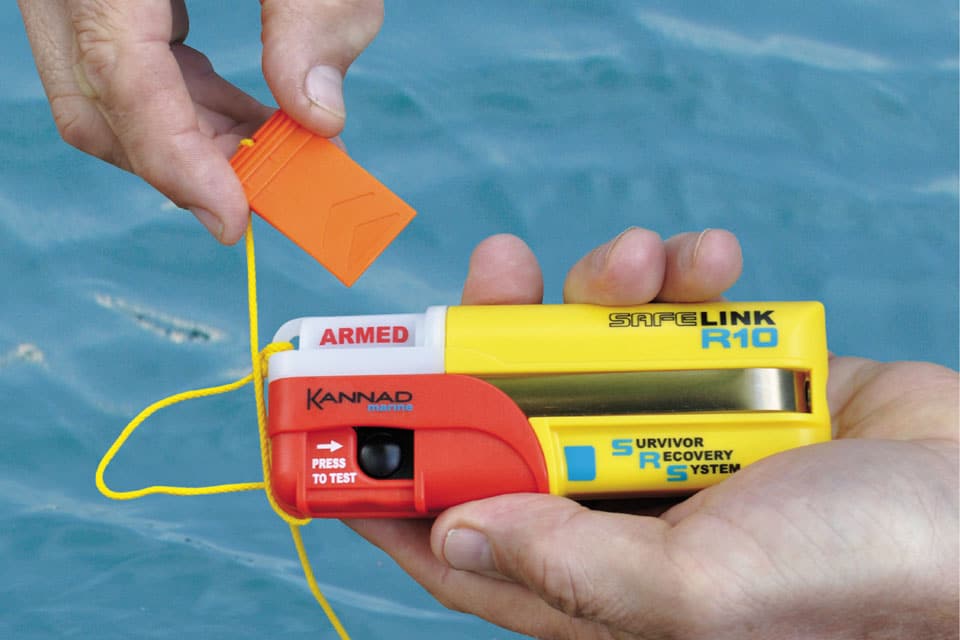
SafeLink R10 PLB
By now, I think we’re all pretty convinced that Emergency Position-Indicating Radio Beacons , better known as EPIRBs, are a good thing. If things go badly aboard your boat, activating an EPIRB will bring help fairly quickly, no matter where in the world you’re located.
As the technology has evolved, the components, and hence the devices themselves, have become smaller—so much so that today, quite capable EPIRB-like systems now come in compact packages that can be carried in pockets or attached to clothing or life vests. In 2003, after a prolonged federal permitting process, the United States approved these small devices for personal use, and personal locater beacons have became another option for safety-minded sailors.
Unlike EPIRBs, PLBs don’t necessarily float, can’t be automatically activated, and are only required to transmit for 24 continuous hours (instead of 48 hours) at temperatures of minus 40 F. Of course, if you’re in distress in warmer waters, both a PLB and an EPIRB will likely transmit for a longer period of time. Besides the main 406-megahertz distress and location frequency, all PLBs and many EPIRBs include GPS for faster position reporting and also transmit on the 121.5-megahertz frequency, which is used for “last mile” homing in by many search-and-rescue providers.
It’s my personal opinion that anyone who spends time on the water in any area should own some type of device that, should you fall overboard, makes it easy for your own vessel or for SAR assets to rescue you. These gadgets are an inexpensive, easy-to-carry way of increasing your odds of survival if you fall overboard or if your boat’s primary EPIRB malfunctions or doesn’t make it into your life raft.
There are also other personal-recovery products that don’t incorporate EPIRB technology but make particular sense for the recovery of men or women who fall overboard. Examples include the new Automatic Identification System crew-overboard beacons that alert your own and nearby vessels equipped with an AIS plotter and also various systems that use the 121.5-megahertz homing frequency or VHF channels to help the crew aboard the vessel quickly locate and recover sailors in the water without help from outside agencies.
The U.S. Coast Guard Navigation Center already references future EPIRBs that will incorporate AIS homing abilities, and I believe that we’ll eventually see PLBs that also combine these technologies. These units will allow a vessel that loses a crewmember to actively participate in the search, which could result in a far more timely rescue.
In the meantime, excellent PLBs and AIS COB beacons are commercially available now; some of these are new models, some are older but no less viable.
ACR has the largest selection of PLBs on the market today, with its latest offerings being the ResQLink and ResQLink Plus . Both units are small, with the ResQLink weighing in at 4.6 ounces and measuring 3.9 by 1.9 by 1.3 inches. The Plus version weighs in at 4.9 ounces and is 4.5 by 1.9 by 1.6 inches. Both units have a 66-channel GPS, blade antennas, and continuous strobes. They also incorporate self-test systems for both the GPS and the 406-megahertz transmitters and the ability to do some through-satellite testing without seriously denting the claimed 30-hour battery life. The only difference between the two is that the Plus model floats. These units have retail prices starting at $325.
ACR also offers the AquaLink and the AquaLink View , both slightly larger units. One difference between them is that the View’s little screen displays such reassuring info as position, battery life, and confirmation that the unit is transmitting. The other is that the AquaLinks have enough battery—35 hours’ worth—so they can use ACR’s 406Link.com through-satellite testing service for a limited number of “We’re here and OK” messages. These devices start at about $220.
McMurdo’s latest personal device is the FastFind 210 , which weighs in at 5.3 ounces and measures 1.3 by 1.9 by 4.0 inches. It has a 50-channel GPS, operates at temperatures down to minus 4 F, and has a flashing LCD light. The FastFind 220 adds a buoyancy pouch. The FastFind Max G is a larger PLB that boasts a 48-hour battery life. These units start at $220.
Kannad offers two 406-megahertz PLBs, the SafeLink Solo and the SafeLink Pro . The Solo, a palm-sized unit encased in rubber, comes with a flotation pouch. It’s waterproof to 10 meters, has a flashing LED light, and provides a minimum of 24 hours of active battery life at temperatures to minus 20 C. The Pro is a slightly larger unit that boasts a 48-hour battery life. Both the Solo and the Pro use both 406 and 121.5 frequencies and have 50-channel GPS reception. Prices start at $270.
The likelihood of carrying a personal locator beacon is directly proportionate to the size of the PLB; in other words, the more convenient it is to carry and use, the more likely you are to wear it. With that fact in mind, Ocean Signal has introduced the rescueME PLB, a tiny (the manufacturer says it’s 30-percent smaller than the next-smallest PLB) unit with a hefty (seven-year) battery life, an integrated GPS with 66-channel capability (for extremely rapid signal acquisition), and one-hand operation. Even after the 24-hour satellite transmit time, the rescueME will continue to assist rescuers because the PLB’s homing beacon and strobe light will continue to operate. The rescueMe is waterproof but doesn’t float. It comes with a detachable floating lanyard, but it’s really meant to be mounted on a PFD, attached via the included rubber mounting strap. Ocean Signal is awaiting final approval from the FCC before releasing the unit for sale in the United States, but it expects that to happen as soon as this spring. Retail pricing on the rescueME slides in line with the other offerings in that market at $250.
Two AIS COB beacons are currently available in the United States: Kannad’s R10 SRS AIS and McMurdo’s Smartfind S10 . Both companies are owned by Orolia, with the former offering devices geared to the recreational sailor and the latter aimed at pros.
The Kannad unit is designed to be attached to a harness/life jacket and is manually activated by pulling a tab, then removing a red arming cap. If the R10 is professionally installed on a harness/life jacket, it can be automatically activated when the life jacket inflates. When the unit is activated, it transmits a distress signal, including the overboard sailor’s position, to all AIS-equipped vessels within, typically, a 4-mile range. The Safelink R10 can transmit a signal for 24 hours and has a flashing LED light and a self-test feature with a battery-use indicator. Prices for this device begin at about $300.
The McMurdo Smartfind S10 is a buoyant AIS personal beacon that has the same range as the Kannad, which is more of an indication that AIS operates via a dedicated digital VHF signal, and as we all know, VHF operates in a line-of-sight manner. The antenna is internally mounted, and expected battery life is 24 hours. Of note to divers looking for a personal AIS beacon, the S10 is waterproof to about 200 feet. Prices start around $320.
Also approved by the Federal Communications Commission is the German company Weatherdock’s EasyRescue personal AIS SART, which is very similar to an AIS COB beacon except that it was developed before the AIS COB title was fully approved. It’s not offered for sale by any U.S. retailers that we could find, but cruising sailors who visit the Caribbean can find it in some chandleries for the equivalent of about $425. The EasyRescue has a tremendous 96-hour battery life, weighs 7.1 ounces, and measures in at 4.9 by 2.6 by 1.1 inches. The company’s very small WamBlee OneMan AIS SART may also be available soon in the United States.
Sea Marshall, a brand recently acquired by Mobilarm, offers what it calls a Maritime Survivor Locating Device, which uses the digital selective calling features on VHF radios. This palm-sized, water-activated unit will send a distress signal on the dedicated DSC distress channel, VHF Channel 70. GPS coordinates for the person in the water will be transmitted to all DSC-equipped radios within range. The final part of the safety net is a synthesized voice transmission on Channel 16, alerting even older, non-DSC-enabled VHFs to the overboard situation. The Crewsafe V100 is configured with what the company calls a regional profile, with different features offered depending on where the unit will be used, subject to the regulatory requirements in place in different parts of the world.
Mobilarm also has a more complex system aimed more at commercial users, the Mobilarm . Worn on a life jacket, the Mobilarm, when activated, transmits an alert on the partially phased-out 121.5-megahertz frequency to a base unit on board the parent vessel that monitors the 121.5-megahertz frequency and raises the alarm when it detects the emergency signal. The base unit indicates the direction and approximate range to the sailor in the water, enabling the crew to carry out the rescue.
Manufacturers • ACR Electronics: www.acrelectronics.com • Kannad Marine: www.kannadmarine.com/en • McMurdo: www.mcmurdo.co.uk • Mobilarm: www.mobilarm.com • Ocean Signal: www.oceansignal.com • Vesper Marine: www.vespermarine.com • Weatherdock: www.easyais.de
CW contributor Tony Bessinger is a U.S. Coast Guard-licensed master and an instructor at Confident Captain/Ocean Pros in Newport, Rhode Island.
Click here to read more about how an EPIRB works.
- More: Electronics , Gear , safety equipment
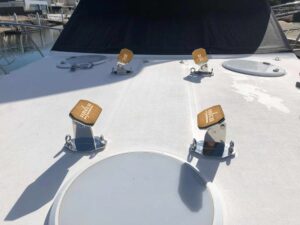
AquaChocks: Secure Tender Storage, Simplified
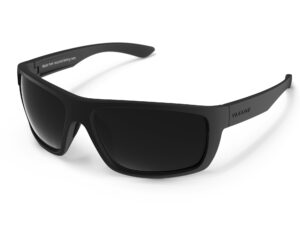
Pro-Grade Sailing Eyewear
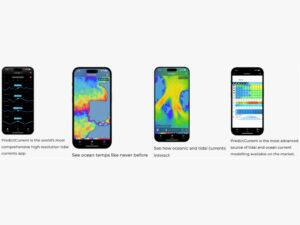
PredictWind Introduces PredictCurrent App

Musto’s MPX Impact is Made for Offshore
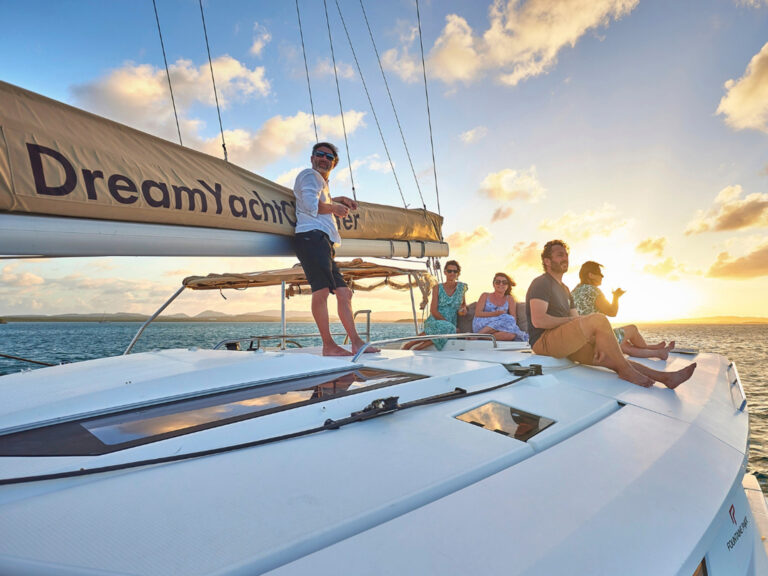
Options To Explore

For Sale: Little Harbor 63 Ketch

Cruising Tahiti: A Party in Paradise
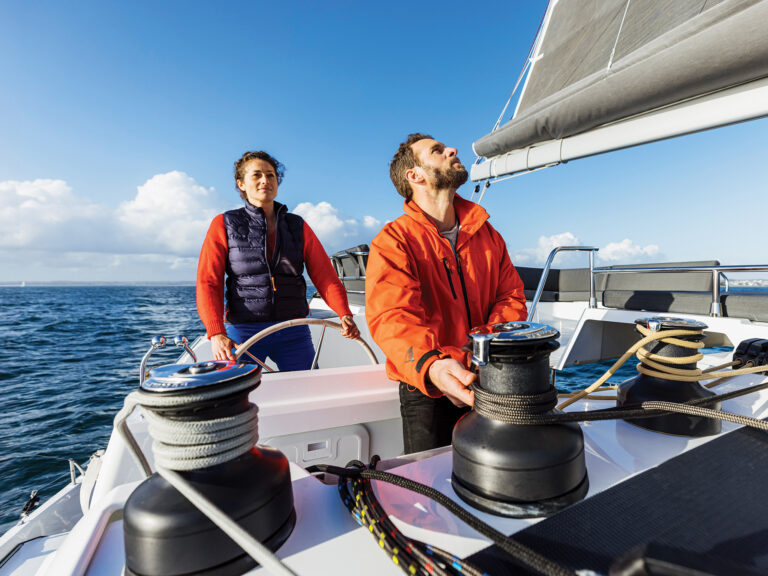
Sailboat Review: Fountaine Pajot Aura 51
- Digital Edition
- Customer Service
- Privacy Policy
- Terms of Use
- Email Newsletters
- Cruising World
- Sailing World
- Salt Water Sportsman
- Sport Fishing
- Wakeboarding

A Guide to Selecting EPIRB Mounting Locations
Settling on a location to place an EPIRB counterintuitively becomes tricker the smaller the boat gets.
Installing your EPIRB correctly and away from magnetic interference from instrumentation is vital to ensure it functions as intended during an emergency.
This is why a smaller boat needs deeper thought which is what I’ll get into in this article.
Installation Best Practices
The most critical factor when selecting your mounting location is to ensure that it’s an area without any overhead obstruction.
This means that in the case of submersion and the device being released by the Hydrostatic Release Unit (HRU), it will float free to the surface.
In the case of manual EPIRBs, this still holds true, but you will need to retrieve the device in an emergency physically. And that’s when accessibility becomes important.
Consider Accessibility
The EPIRB should be easily reachable, allowing for quick deployment in case of an emergency.
Locations within arm’s reach of the helm or the companionway are often ideal for accessibility.
Environment Factors
Think about environmental exposure.
Your EPIRB should be mounted in a location that’s protected from prolonged direct sunlight and shielded from frequent saltwater spray .
Avoid areas like the foredeck where heavy seas can impact it, and places where it could be damaged by a swinging door.
Avoid Fire Sources
It’s critical to mount the EPIRB away from potential fire hazards such as the engine room or galley .
Ensure that the EPIRB is in a location where it can be seen by the crew, reminding them of its presence and function.
Mounting EPIRBs Step-by-Step
1️⃣ Select Bracket Type:
For Category I brackets, which deploy the EPIRB automatically when submerged, refer to guidance from manufacturers like ACR Electronics.
For Category II brackets requiring manual deployment, ensure they’re secured but accessible for manual retrieval.
2️⃣ Mounting Process:
Firstly, identify the optimal mounting location following the guidelines above.
Confirm that the chosen location also allows the EPIRB to float free without obstruction in an emergency.
Proceed to securely attach the mounting bracket to the hardtop , cockpit , or another suitable location with the provided hardware, ensuring it remains accessible and visible.
🎓 Note: Always follow the manufacturer’s instructions during the installation process to ensure that the EPIRB will function correctly when needed.
EPIRB Registration and Maintenance
Before you set sail, ensure your EPIRB is registered and maintained to guarantee it functions in an emergency.
Accurate registration and consistent maintenance are critical for the effectiveness of this lifesaving device.
Registering Your EPIRB
In the United States, the U.S. Coast Guard requires your beacon’s registration to be updated every two years, or when your contact information or the device’s ownership changes.
Registration is a straightforward process that can be completed online, attaching key details such as your contact information, emergency contacts, and vessel identification to your beacon.
- Register your EPIRB
Battery Replacement and EPIRB Testing
Your EPIRB battery has a limited lifespan and should only be replaced by an authorized service center.
Typically, batteries need replacement every five years but always refer to your manufacturer’s guidance to confirm the schedule.
Regular testing according to the owner’s manual ensures your EPIRB is performing correctly.
It’s recommended to test its functions annually, which includes verifying signal transmission and battery strength.
Choosing and Purchasing EPIRBs
When selecting an EPIRB, consider your boat type and usage to ensure you get an appropriate device.
The decision between renting and purchasing depends on your boating frequency and needs.
EPIRB for Different Boat Types
EPIRBs are a critical safety component for a range of vessels, including cruising boats , pontoon boats , fishing boats , runabouts , and even personal watercraft (PWC) .
For vessels like cruising boats, where long-distance travel is common, choosing an EPIRB with extended battery life and durability against harsh weather conditions is vital.
- Cruising Boats : Opt for Category 1 EPIRBs with GPS capabilities for precise location tracking.
- Fishing and Pontoon Boats : Consider Category 2 EPIRBs, which require manual deployment.
- Runabouts & PWC : A Personal Locator Beacon (PLB) may suffice for these typically smaller craft.
Rent vs. Purchase EPIRB Options
The decision to rent or purchase an EPIRB often hinges on how frequently you use your boat.
| Option | Ideal for | Benefits |
|---|---|---|
| Rental | Ideal for occasional boaters | Cost-effective, Up-to-date EPIRB |
| Purchase | Best for regular boaters | Always on board |
⚠️ Remember: If you’re renting, it’s your responsibility to ensure the rented EPIRB is properly registered and functional for the duration of your boating excursion.
Frequently Asked
Are there specific guidelines for mounting an epirb on small boats compared to larger ships.
While the core guideline is the same—easy accessibility in case of emergency—smaller vessels may require more careful placement due to limited space.
It’s recommended to keep the EPIRB away from magnetic interference and secure it well to prevent loss overboard.
Can an EPIRB be mounted horizontally, or does it need to be vertical?
Your EPIRB should be mounted vertically wherever possible. This orientation is designed to ensure the best signal transmission and to align with the way hydrostatic release mechanisms function if utilized.
At what distance from shore is it necessary to have an EPIRB on board?
The necessity of an EPIRB on board is not solely dictated by the distance from the shore. It is crucial for both coastal and offshore voyages where immediate rescue may be required. It’s an essential safety device for any vessel capable of sailing beyond rapid assistance range.
Written by:
I’m the founder and chief editor here at Sailing Savvy. I spent a decade working as a professional mariner and currently, I mix those experiences with digital publishing. Welcome, and I hope that we can be the hub you need for safe passage.

Where Should You Mount An EPIRB On A Boat?
The EPIRB is the one device on a boat that is capable of automatically sending a distress signal from anywhere in the world, independent of all other systems you might have on board. To make full use of it, however, it is crucial to mount it correctly. So, where should you mount an EPIRB?
You should mount your EPIRB clear of all overhead obstructions, where it will float free in an emergency. It should be easily accessible so that you can quickly grab it if you take to your liferaft. Popular locations include the top of the cabin roof, adjacent to the helm, or on handrails near the stern.
The most important thing, however, is to mount your EPIRB in a location that makes sense for your boat.
Where Could You Mount an EPIRB?
You could mount your EPIRB anywhere you like. Most importantly, you should consider what is best for your EPIRB and your boat.
If your boat is small and open to the elements, protecting the EPIRB is likely going to be your priority. If you have a larger vessel, easy access may be more important for you. If you are on a sailing boat, keeping clear of the mast and rigging might be your priority.
Mounting an EPIRB on the Center Console
A lot of small boat owners prefer to mount their EPIRB on the center console. The huge advantage of this is that the EPIRB is easily accessible should you want to abandon ship.
Additionally, on the smallest boats, the center console is quite a good location for it to float free. Of course, if you have a canopy of any sort, or your center console is inside, the console is not such a great position.
If there is any sort of covering, you can expect that your EPIRB will not be able to float free. More likely, it will just float up and just get caught in the roof instead.
The other consideration is in the event of a capsize. If your boat turns straight over, it is likely to be impossible for the EPIRB to float clear. It is likely to just get trapped in the upturned hull.
Mounting on the center console is good if you intend to always carry your EPIRB to your survival craft. Your EPIRB would be a Category 2 EPIRB, as it is unlikely to be able to float free (except on the smallest of boats). If you do mount on the center console, ideally, you will carry a PLB or a second EPIRB as a backup.
Mounting an EPIRB on the Cabin Roof
Another common location on smaller boats is mounting your EPIRB on the cabin roof. Compared to mounting on the center console, the cabin roof has one major advantage. The EPIRB should be able to float free in an emergency.
Should your boat sink straight down, the cabin roof gives the greatest chance of the EPIRB floating clear. You do need to make sure that there are no fittings or masts above the EPIRB that could hinder its passage to the surface.
Depending on the shape of your cabin, there is a chance the EPIRB will also be able to float free in the event of a capsize.
You just need to imagine what the roof looks like inverted. If there are deep combings around the edge they could catch your EPIRB. Additionally, if your roof slopes towards the cockpit, the EPIRB would probably just bounce along that and get trapped in the upturned hull.
The final consideration for the cabin roof is its accessibility. Is it easy to get to if you need to abandon ship quickly? Imagine there is a fire in the cabin and you just need to get away. Could you easily grab the EPIRB as you run past?
Mounting an EPIRB on the Foredeck
Similar to the cabin roof, the foredeck gives the EPIRB a good chance of floating free in an emergency. The disadvantage compared to the cabin roof is that in the event of a capsize, the foredeck could be shallower. This reduces the chance of the foredeck getting the EPIRB deep enough to activate a HUR (Hydrostatic Release Unit).
Incidentally, I have made a video about how HRUs work.
The foredeck probably does, however, give a clearer path for the EPIRB from an upturned hull. There is normally less in the way of deep combings, and less chance of it finding its way inside the hull.
The major disadvantage of mounting on the foredeck is accessibility. On a small boat, access to the cabin is usually from aft. If you are running away from a fire, there is less chance of your path crossing the foredeck.
If you mount your EPIRB on the foredeck, it’s good practise to have a secondary EPIRB, or a PLB. The one on the foredeck could be Category 1, and the secondary one could be Category 2.
Mounting an EPIRB on the Railings
Another common location for mounting an EPIRB is on your boat’s railings. If it is mounted outside the railings, there is a reasonable chance that it will float free. Both in the event of sinking vertically, and in the event of a capsize.
There is a good chance that railings will be more accessible than the foredeck and the cabin roof. It makes it significantly easier to reach the EPIRB if you need to abandon ship in a hurry.
The biggest consideration when mounting your EPIRB on the railings is exposure. EPIRBs are designed to withstand a lot, but you want to make sure the mounting is suitable.
Another consideration is the height of the railings. You need to imagine your boat upturned and think how deep the EPIRB would go. Is it deep enough to activate the HRU?
Mounting an EPIRB on a Sailing Boat
Sailing boats are one of the more challenging when choosing a location for your EPIRB. You have sails and rigging, which could all snag an EPIRB floating free.
The sailing boats I have seen tend to either mount their EPIRB on the foredeck, or on railings near the stern. Capsize is one of the biggest risks on a sailing boat. Both the foredeck and the railings do offer a chance of the EPIRB floating clear during a capsize.
The railings would be preferable if you only have one EPIRB as it is so much more accessible. If every crew member is issued with a PLB, however, the foredeck may be a better location.
Keeping your EPIRB in a Grab Bag
Another popular location for the EPIRB is in the grab bag. Especially if you have a Cat 2 EPIRB that isn’t designed to float free.
Once you make the decision to buy a Category 2 EPIRB, you have accepted that it will need manual activation. You need it to be easily accessible so that you can grab it as you run past. The exact same criteria applies to the grab bag, so it makes sense to keep them together. You will find a lot of grab bags have a pocket specifically designed for this purpose anyway.
If you have decided that a Category 2 EPIRB is enough for you, the grab bag is an ideal location for it.
What to Consider when Choosing where to Mount Your EPIRB
We have already discussed some considerations above. You need to take into account as much as you can to find the optimal position for your own EPIRB.
Ask yourself this: If my boat sank straight down vertically, would my EPIRB float free?
Look straight above the mounting position and check for obstructions. Some may pose more of a threat that others. A canopy, for example, would be more of a hindrance than the rigging.
When you consider the sinking scenario, only think about vertical sinking. It is best to consider capsize separately.
Ask yourself this: If my boat capsized, and I was trapped in the hull, would the EPIRB float free?
It is slightly harder to imagine your boat upside down. You can, however, just change your way of thinking. Instead of thinking of the buoyancy of the EPIRB, think of gravity. Try to find an object similar in shape to your EPIRB. A foam ball or an old bottle can work well.
Place it where you plan to mount the EPIRB and let go. Does it roll around and eventually fall off the boat? If so, there is a good chance the EPIRB will do similar and float clear of your upturned hull.
Remember, there is a lot of movement during a capsize. You can jiggle your object a little bit if needed. When your boat capsizes, it is unlikely to be a gentle process.
Finally, consider the activation depth of the EPIRB. Will it be pushed deep enough to activate the HRU during a capsize?
Abandon Ship
Ask yourself this: If I was running away from a fire, would I be able to grab the EPIRB on the way?
You can consider where you spend most of your time, and the chance of your escape path passing your EPIRB. You won’t be able to account for every eventuality, but you can assess the most likely scenarios.
Ideally, your EPIRB would be accessible near the exit of your accommodation or close to the main helm position. When your boat is underway, the helm should be manned the whole time. At night, other crew will most likely be inside the cabin.
In either case, think about the path that people will take as they try to escape. Will they pass the EPIRB’s storage location?
Protection of the EPIRB
Ask yourself this: Is the EPIRB protected in its storage location?
EPIRBs are designed to withstand sunlight and exposure, but it is better if you can minimise it as much as possible. Category 1 EPIRBs will most likely have an additional outer case, so you can factor that in too.
Try to consider more than just exposure though. Is the EPIRB mounted next to an onboard hazard? Make it is not close to potential sources of fire: fuel, engine room etc.
Finally, how well protected is it from daily life onboard? You don’t want to mount it in the companionway if crew are going to knock it every time they pass. Make sure you watch out for ropes and lines as well.
Where to Mount a Category 1 EPIRB
Category 1 EPRIBs are those that are designed to float free and automatically activate.
You need to mount Category 1 EPRIBs in the location that will give it the best chance of floating free in an emergency.
I personally quite like to use the railings on one of the quarters. It gives it a reasonable chance of floating free in a capsize, or sinking scenario. Depending on the height of the railings, I would consider using a pole to increase its depth in a capsize scenario.
Using the quarters, it is also close enough to be accessible to take to a survival craft.
It is kept clear of daily knocks and bashes from the crew. There is minimal chance of people passing close by to knock it.
Finally, it is clear from the galley and other hazards on board. It might be close to the engine, but that is a compromise that I would make given the other advantages of the location.
Where to Mount a Category 2 EPIRB
Category 2 EPRIBs are manually activated and do not float free.
As such, you need to mount a Category 2 EPIRB in the most accessible location you can. I would keep my Category 2 EPIRB inside my grab bag. In turn, I would keep the grab bag close to the helm position.
If I didn’t have a grab bag, I would keep the EPIRB close to the helm position anyway. I’d work on the assumption that the helm is the only place onboard that is likely to be continuously manned. Additionally, the helm is often close to the cabin entrance, so it would be on the escape path out of the cabin.

Please verify you are a human
Access to this page has been denied because we believe you are using automation tools to browse the website.
This may happen as a result of the following:
- Javascript is disabled or blocked by an extension (ad blockers for example)
- Your browser does not support cookies
Please make sure that Javascript and cookies are enabled on your browser and that you are not blocking them from loading.
Reference ID: 5bdffafc-60d3-11ef-b501-8f9ae779bd3c
Powered by PerimeterX , Inc.
Emergency Beacons
Epirb rental program - low-cost boating safety equipment since 1997. learn more about our program below..

Reliable Equipment.
Shipped directly to you. no hassle peace of mind so you can have a great trip..
Your crew relies on you to have the essential safety equipment when you go boating – and that takes a reliable partner. At the BoatUS Foundation for Boating Safety and Clean Water we have the largest inventory of rental emergency beacons in the country. We proudly offer emergency position indicating radio beacons (EPIRBs) for the boat and personal locator beacons (PLBs) for the crew. Place your order online or by phone and we will get the equipment to you when you need it.
Why Rent an EPIRB or PLB?
For the boater making occasional offshore trips outside of reliable vhf range, it pays to rent:.
- No large investment in equipment that has a limited life-span
- We handle the NOAA registration so the unit is ready when you get it
- We cover the equipment maintenance
- No expensive battery replacement every 5 years
- Easy online ordering with no security deposit required

Best EPIRB: 5 emergency beacons for leisure sailors
The emergency position indicating radio beacon (EPIRB) seems like an expensive little gadget to have clipped to a bulkhead in the hope it never gets used, but if you do intend to, or regularly do head out of sight of land then you really should have at least one on board. But, what’s the best EPIRB for your boat and your sailing activity?
If you regularly cruise or race out of sight of land then an Epirb is an absolutely essential bit of kit to have fitted to your boat.
There’s a few on the market though and they vary in price. Tech Editor, Fox Morgan takes a look at those currently available on the market and compares the specs to see exactly what it is you’re buying.
Most of us will hopefully never need to use an Epirb and wonder why exactly we have this expensive piece of electronics clipped to a bulk head.
What level of specification and what budget you have for it is probably the first consideration.
First there’s cat 1 and cat 2 types. If you are racing, then the rules might state you must have a hydrostatically released Cat 1 version. For most leisure users a cat 2 type will be just fine.
Do you want to have built in AIS? There’s two currently to choose from on the market.
Do you want Return Link Service? There’s only one model currently offering this.
Do you want a really small unit that can slip into a grab bag? Or do you want something you can operate without your glasses and be a substantial object to handle with cold wet hands?
At a glance
Best top of the range Epirb – Ocean Signal RescueME EPIRB3 – Buy it now
Best Epirb for a grab bag – Ocean Signal RescueME EPIRB1 – Buy it now
Best Epirb on a budget – ACR GlobalFix V4 406 GPS EPIRB – Buy it now
Ocean Signal RescueME EPIRB1
Reasons to Buy: Long battery life, user serviceable battery, very small compact unit
Reasons to Avoid: the antenna must be pulled out before activation, small unit might be a bit of a fiddle for larger hands
Ocean Signal make a well-regarded range of safety beacons, and their EPIRB1 is the smallest on the market. It has a 10-year battery life, and 48+ hours operational life. Being such a compact model as Cat 2 version, this will fit to some small bulkhead spaces and will slip easily into a grab bag.
It also has a 66-channel internal GPS and a retractable antenna which you must remember to pull out when activating manually. Hidden under the rubber band is the lanyard to allow the unit to float outside of a liferaft and remain tethered.
The Pro version of the EPIRB1 offers an an automatic release housing.
Specification • Operational life – 48+ hours • User replaceable battery – yes • Battery life – 10 years • Auto activation – No (cat 2) Yes (cat 1) • AIS – No • GPS – Yes • 121MHz – Yes • NFC – No • Return Link Service – No
Buy Ocean Signal RescueMe Epirb1 on Amazon (UK)
Buy Ocean Signal RescueMe Epirb1 on Amazon (US)
Buy Ocean Signal RescueMe Epirb1 on eBay
Note: We may earn a commission when you buy through links on our site, at no extra cost to you. This doesn’t affect our editorial independence.

Ocean Signal RescueME EPIRB3
Reasons to Buy: the most highly specified leisure boaters epirb on the market, AIS, NFC
Reasons to Avoid: may be a little pricey for some, the antenna must be pulled out before activation, small unit might be a bit of a fiddle for larger hands
The latest epirb from Ocean Signal brings a host of new features to an already familiar compact unit.
The Epirb3 has AIS, which makes localised rescue easier for any vessel equipped with a receiver and near field communication which allows easier viewing of the unit’s battery status.
The other most notable addition is the return link service, which is an indicator light on the unit that acknowledges receipt of distress signal at a rescue center.
Everything else remains largely the same as the epirb1.
You can tell the two apart with their top housing, the Epirb3 is transparent whilst the Epirb1 is opaque.
Specification • Operational life – 48+ hours • User replaceable battery – yes • Battery life – 10 years • Auto activation – No (cat 2) Yes (cat 1) • AIS – Yes • GPS – Yes • 121MHz – Yes • NFC – Yes • Return Link Service – Yes
Buy it now from Suffolk Marine Safety

ACR GlobalFix V4 406 GPS EPIRB
Reasons to Buy: large easy to handle unit, antenna always ready, simple stowage bracket
Reasons to Avoid: larger bracket requires more space on a bulkhead
This EPIRB has an internal 66-channel GPS, and a user-replaceable battery pack. It has a high-visibility LED strobe light, floats, and can be automatically activated via cat 1 hydrostatic release in housing or manually activated by cat 2 manual mount.
It claims 48+ hours run time, and comes with a 5-year warranty. The antenna is held by the bracket but deploys instantly on release.
Specification • Operational life – 48+ hours • User replaceable battery – yes • Battery life – 10 years • Auto activation – No (cat 2) Yes (cat 1) • AIS – No • GPS – Yes • 121MHz – No • NFC – No • Return Link Service – No
Buy ACR GlobalFix V4 EPIRB on Amazon (UK)
Buy ACR Globalfix V4 EPIRB on Amazon (US)
Buy ACR GlobalFix V4 EPIRB on eBay

McMurdo SmartFind G8 AIS EPIRB
Reasons to Buy: Large easy to handle unit, clear manual trigger, always ready aerial
Reasons to Avoid: larger bracket requires more space on a buklhead
As well as 406MHz and 121.5MHz transmitters, this EPIRB also includes an AIS transmitter to give local vessels location information and thus increase the chance of rescue by nearby craft.
It has a 77-channel multi-constellation GNSS receiver, manual/automatic activation, strobe light and 48 hours operating time thanks to a Lithium Ion battery that is good for 10 years before it needs replacing.
Specification • Operational life – 48+ hours • User replaceable battery – No • Battery life – 10 years • Auto activation – Yes (Cat 1) No (Cat 2) • AIS – Yes • GPS – Yes • 121MHz – Yes • NFC – No • Return Link Service – No
Buy McMurdo Smartfind G8 AIS EPIRB on Amazon (UK)
Buy McMurdo Smartfind G8 AIS EPIRB on Amazon (US)
Buy McMurdo Smartfind G8 AIS EPIRB on eBay

GME MT600G GPS EPIRB
Reasons to Buy: budget friendly price, simple unit
Reasons to Avoid: a basic unit that doesn’t have some more sophisticated features of others, might be harder to find to purchase
The MT403 EPIRB has a 16-channel GPS receiver, a high visibility strobe light and can be automatically or manually activated. I and has a 10-year battery life and 6-year warranty included.
Specification • Operational battery life is 48 hours, and a mounting bracket is included. • Operational life – 48+ hours • User replaceable battery – No • Battery life – 10 years • Auto activation – Yes (Cat 1) No (Cat 2) • AIS – No • GPS – Yes • 121MHz – No • NFC – No • Return Link Service – No
Buy GME MT603G from Amazon.co.uk
Buy GME MT603G from Sartech.com
What we look for in an EPIRB?
- Internal GPS: Nearly all of the best EPIRBs available on the market today will have an integrated GPS, but if you have an older model, some of these don’t, which can mean they are much slower and less accurate at pinpointing your location
- User serviceable battery: You might like to consider a model which allows you to change the battery yourself. Service centres can be costly but do offer peace of mind in return for an increased cost.
- Auto activation: Some of the best EPIRBS can be automatically activated upon immersion, and some housings will automatically release the EPIRB to float free should it become submerged, this is mandatory for SOLAS vessels.
- Retractable Antenna: These prevent damage when stowed, but must be deployed to allow the beacon to reach its full range potential.
- Dual-Frequency: Whilst all will transmit initially on 406MHz, some offer additional 121.5 MHz for accurate search and rescue homing. Some models have an AIS transmitter for local position pinpointing instead.
- Registration: Each EPIRB comes pre-programmed with a country code, so beware of buying EPIRBs online from other regions. You must register your EPIRB with the MCA in the UK . or the NOAA if you are based in USA
For past adventures and tales of rescue at sea you can read more at Yachting World and the 2020/21 Vendee Glove recue of Kevin Escoffier
Read how a PLB saved Solo Yachtsman, Nigel Fox’s life at Yachting Monthly
Looking for a personal beacon? Read our buyers guide to help you choose the best one for you: Best personal locator beacons and AIS units: 8 top options for boating
Didn’t find what you’re looking for? Head to Amazon’s dedicated boating page for more marine products.
Related Posts

Leave a Reply Cancel reply
Your email address will not be published. Required fields are marked *
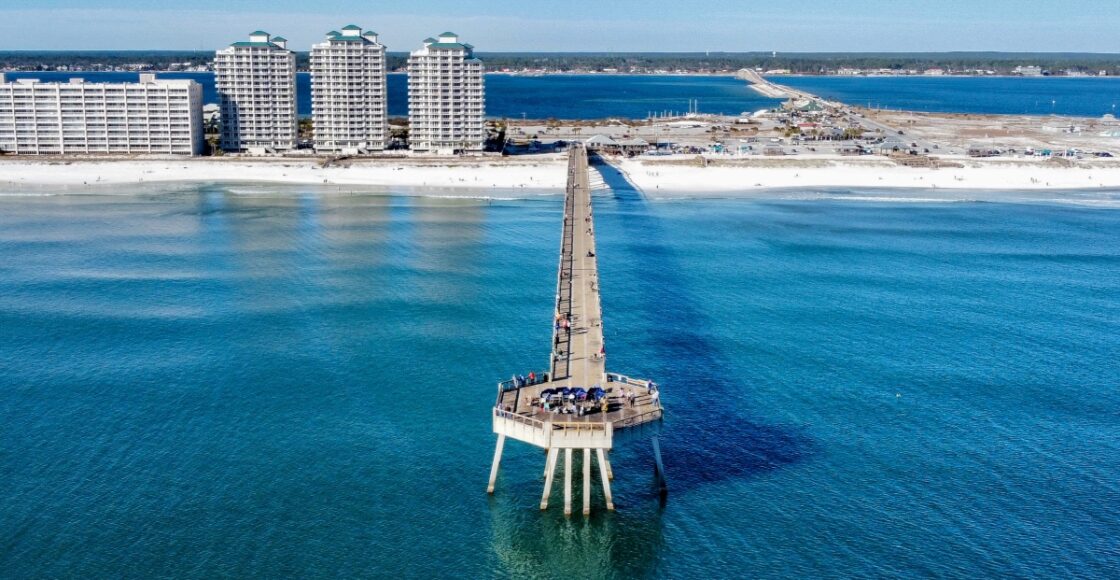
5 Best Beaches in Pensacola

Table of Contents
Last Updated on August 22, 2024 by Boatsetter Team
Nestled along Florida’s Emerald Coast, Pensacola boasts some of the most stunning beaches in the Sunshine State. With its sugar-white sands, emerald-green waters, charming beachside communities, it comes as no surprise why Pensacola beaches are so popular. Whether you’re looking to anchor off shore crab island or cruise along bustling shores, Pensacola ‘s diverse beaches cater to every boating enthusiast’s dream. Let’s set sail and explore the best beaches in Pensacola.
Pensacola Beach
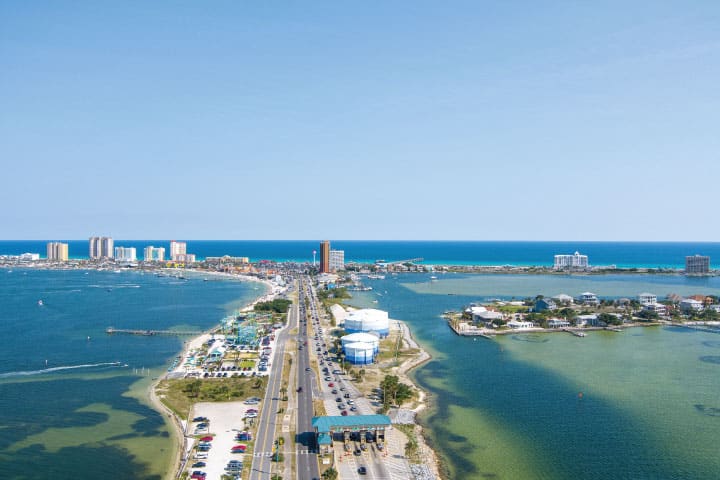
Pensacola Beach, the crown jewel of the area, stretches for miles along Santa Rosa Island. Its crystal-clear waters and powdery sand make it a favorite among locals and visitors alike. Anglers love it here fishing for cobia and occasionally sailfish. If you’re interested in underwater exploration, find a boat with snorkeling gear and anchor near the pier which is home to a diverse marine ecosystem.
Explore boat rentals near Pensacola Beach
Perdido Key
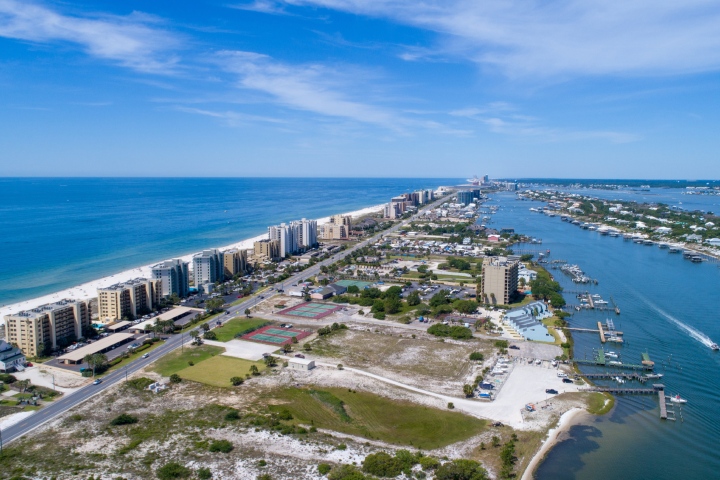
For those seeking a more secluded experience, Perdido Key offers miles of unspoiled coastline. This narrow strip of land between Pensacola and Orange Beach, Alabama, is a haven for nature lovers and boating enthusiasts. The calm waters of Big Lagoon on the north side of the key provide ideal conditions for kayaking and paddleboarding. On the Gulf side, boaters can enjoy fishing for red snapper or simply anchoring off the pristine shores for a day of sun and relaxation.
Explore boat rentals near Perdido Key
Johnson Beach
Part of the Gulf Islands National Seashore, Johnson Beach offers a pristine natural setting away from the crowds. Accessible by boat, this 7-mile stretch of untouched coastline is perfect for those looking to commune with nature. Cruise to the beach’s western end, known as Perdido Key Area, for secluded coves and inlet. The calm waters on the sound side are perfect for a leisurely swim or practicing standing up on a paddleboard.
Explore boat rentals near Johnson Beach
Fort Pickens Beach

History buffs and beach lovers alike will appreciate Fort Pickens Beach. Located at the western tip of Santa Rosa Island, this beach offers a unique blend of historical significance and natural beauty. After you’re done exploring the 19th-century fort, hop on a boat, anchor off the shore of a secluded beach, and dive into warm Gulf waters. If you’re looking to go for a deepdive head to the old pier ruins, where the sea turtles and colorful tropical fish love to hangout.
Explore boat rentals near Fort Pickens Beach
Navarre Beach
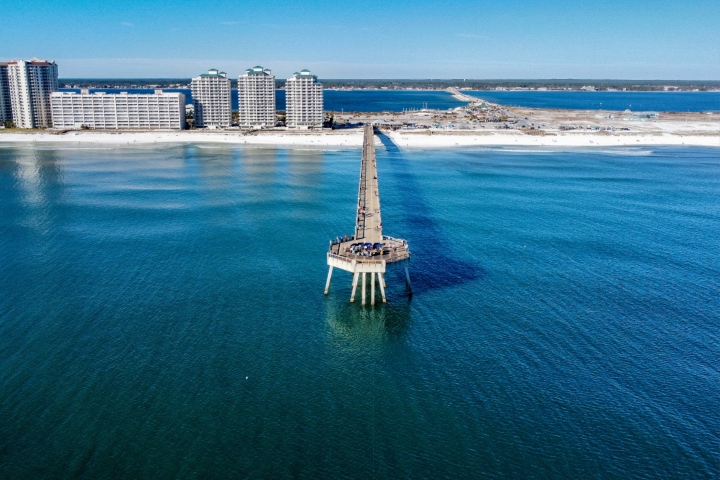
Known as Florida’s best-kept secret, this beach boasts 12 miles of pristine shoreline. Go Snorkeling in the Navarre Beach Marine Park, which features an artificial reef system perfect for snorkeling and diving. Or, cruise over to the north side where the calm waters of Santa Rosa Sound provide ideal conditions for paddleboarding and kayaking.
Explore boat rentals near Navarre Beach
Whether you’re looking for a day of water sports, a peaceful cove, or a fishing adventure, exploring the emerald waters of the Gulf Coast by boat provides a one-of-a-kind perspective of these beautiful beaches and creates unforgettable memories. Don’t miss the chance to discover the hidden gems, vibrant marine life, and fishing game of Pensacola.
Boatsetter is the leading online marketplace for boat rentals and on-water experiences. Download the Boatsetter app ( App Store | Google Play ) and follow us on Instagram .

Boatsetter empowers people to explore with confidence by showing them a world of possibility on the water. Rent a boat, list your boat, or become a Boatsetter captain today.
Browse by experience

Explore articles
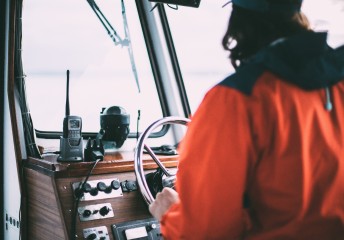
Boat Rental Captain Success Story: Meet Captain Larry!
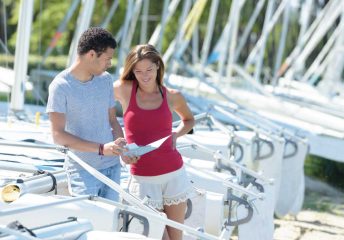
Trade-In Boat Values: NADA Guides & Blue Book

Boating Essentials: Top 10 Things to Bring on Your First Boat Rental
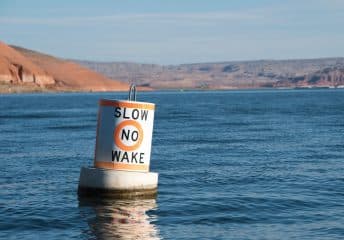
No Wake Zone & Other Boating Regulatory Zones Explained
This is Wales' best pub and you can get there by boat
A pint in the pub is like stepping back in history but is rooted right in 2024 as it picks up CAMRA's Welsh pub of the year
- 00:01, 21 AUG 2024
- Updated 06:57, 21 AUG 2024

Want the best food, film, music, arts and culture news sent straight to your inbox?
We have more newsletters
A Pembrokeshire pub has been named Wales' best pub by by a top guide and will now go head to head against the best in the UK. The Cresselly Arms in Cresswell Quay has been named as the best pub in Wales as part of CAMRA’s (Campaign for Real Ale ) Pub of the Year 2024 competition.
Dating back to the 1880s, the Victorian public bar has changed little over the centuries. Alongside being Grade II listed, the homely farm kitchen interior is of national historic interest, with a red and black quarry-tiled floor, roaring open cast-iron fireplace, Victorian-era counter and bar-back shelves held up by slender columns.
Accessible by boat (kayaking or canoe trips) from the Milford Haven estuary or by paddlebaord. at high tide and a short drive from Tenby, the pub also lies on a series of interesting walking routes, making it a popular destination for hikers. The Cresselly Arms is a haven for locals and tourists alike, staging community events and collaborating with street food vendors like Feast Pembroksihre and We Love Curry, while serving four excellent cask beers.
READ MORE: The stunning Welsh beach with golden sands and an unusual connection to Harry Potter
DON'T MISS: Islands like the Caribbean which are just 200 miles from Wales
On a sunny summer's day the pub is the perfect place to watch the sun go down over the estuary - if you can get a table that is. Understandably due to its location this popular pub gets busy in the warm weather .

After battling it out to be the best pub in Wales, the Pembrokeshire pub will now go up against 16 others from regions across the UK to get the top spot. Pubs in the competition are scored on their atmosphere, decor, welcome, service, inclusivity, overall impression, but most importantly – the quality of live beer, real cider and perry.
Last year’s UK National Pub of the Year winner was the Tamworth Tap in Staffordshire, which won the crown consecutively in both 2023 and 2022. Find out about the latest events in Wales by signing up to our What's On newsletter here
In announcing Wales' winner, CAMRA says it is campaigning for stronger planning protections for pubs in Wales, calling on the Welsh Government to require planning permission to be granted before a pub can be converted into another use or demolished so that communities can have a chance to save their local if developers are trying to get rid of it against their wishes.

Andrea Briers, National Coordinator for the Pub of the Year competition says: “These amazing pubs really are the crème de la crème and I would encourage the public to seek out the 17 winners from across the nations and regions of the UK – they are top-tier pubs serving excellent beer, cider and perry, run by welcoming, hardworking staff."
“It’s also important to support your local all year round. With constant pressure from stubbornly high energy prices, fluctuating running costs and grossly unfair business rates threatening to drown pubs across the UK, it’s vital to get out and support the licensed trade.”
Here are some of the others battling it out to be named best in the UK in 2024:
Central Southern - Bell Inn, Aldworth
East Anglia - Blackfriars Tavern, Great Yarmouth
East Midlands - Horse and Jockey, Stapleford
Greater Manchester - Northumberland Arms, Marple Bridge
Kent - Nelson Arms, Tonbridge
Greater London - Little Green Dragon, Winchmore Hill
Merseyside and Cheshire - Turks Head, St Helens
North East - Grey Horse, Consett
Northern Ireland - Dog and Duck, Lisbellaw
Scotland - Hillend Tavern, Dalgety Bay
South West - Crossways Inn, West Huntspill
Surrey and Sussex - Brickmakers Alehouse, Bexhill on Sea
Wessex - Woodman Inn, Bridport
West Midlands - Bailey Head, Owestry
West Pennines - Black Horse, Preston
Yorkshire - Three B’s, Bridlington
- Pembrokeshire
- Most Recent


IMAGES
COMMENTS
Ocean Signal make a well-regarded range of safety beacons, and their EPIRB1 is the smallest on the market. It has a 10-year battery life and 48+ hours of fo operational life. Being such a compact ...
Type of beacon: EPIRB. Best for: Offshore/coastal/Great Lakes cruisers venturing outside cellphone range, boat crews with medical conditions, areas where assistance from other boaters is unlikely. Price range: $800 - Shop now. Comparable products: ACR GlobalFix V4 406 GPS, McMurdo SmartFind G8 AIS, GME MT600G GPS.
Garmin is the brand to beat when it comes to EPIRB. This is the Cadillac of emergency position beacons. They make a wide range of devices to handle any boater's needs. They also have you covered when you need car GPS as well. Hands down, their best model is the InReach Explorer.
10 Best EPIRBs Emergency Position Indicating Radio Beacon in 2023. Captain Cody WabiszewskiApril 1, 2023. EPIRB stands for Emergency Position Indicating Radio Beacon. These are registered to a boat in case of an emergency offshore. Category 1 EPIRBs containers allow the device to be activated automatically if the vessel sinks.
Ocean Signal SafeSea EPIRB1 Pro. The world's most compact EPIRB pairs compact stature with durability. The EPIRB1 Pro is a reliable emergency beacon, perfect for various water-based activities. Pros. Compact design with a 10-year battery life. 406 MHz satellite band for international distress frequencies.
Starting, we have the ACR GlobalFix V4 Cat 2 and ACR GlobalFix V4 Cat 1 EPIRB. These two products are quite similar as they are produced by the same manufacturers and are the same model. However, while the Cat 2 is manual, Cat 1 is automatic. Check Price & Reviews.
Personal locator beacons (PLBs) PLBs are miniature EPIRBs for personal use. They transmit on both 406MHz and 121.4MHz, but owing to their size the transmission battery life is only a minimum of 24 ...
How PLBs Differ from EPIRBS. While EPIRBs are for boats, PLBs are for personal use. PLBs are smaller than EPIRBs and when activated have a shorter battery life. Like EPIRBs, they operate on the 406 MHz and 121.5 MHz frequencies and provide the same worldwide coverage. They also require registration to a government database; but rather than ...
Battery Can Be Easily Changed Following Its 10-Year Storage Period. BEST: HIGH-TECH EPIRB. The benefits of this EPIRB device are clear: it utilizes multiple channels to broadcast your distress signal in the event of activation in an emergency, including 406MHz, 121.5MHz, AIS, and GPS.
EPIRBs 101: The Essential Safety Device Every Mariner Must Have. EPIRBs (Emergency Position-Indicating Radio Beacons) are critical safety equipment used in yachting. An emergency locator transmitter is a proper lifeline in emergencies, providing a vital link between the vessel in distress and search and rescue services.
EPIRBs. Emergency Position-Indicating Radio Beacons (EPIRBs) are signaling devices that help locate a vessel in distress. These devices interface with the worldwide service of COSPASS-SARSAT, the international satellite system for SAR. The greatest chance of survival is being found quickly so these beacons come with an average activated battery ...
The emergency position indicating radio beacon (EPIRB) seems like an expensive little gadget to have clipped to a bulkhead in the hope it never gets used, but if you do intend to, or regularly do head out of sight of … Continue reading "Best EPIRB: 5 emergency beacons for leisure sailors"
Ocean Signal RescueMe personal locator beacon. Specifications: battery life when activated 24 hours. Battery service life: 7 years. dimensions 7.7cm x 5.1cm x 3.25cm, Weight 116g. Reasons to buy ...
McMurdo's latest personal device is the FastFind 210, which weighs in at 5.3 ounces and measures 1.3 by 1.9 by 4.0 inches.It has a 50-channel GPS, operates at temperatures down to minus 4 F, and has a flashing LCD light. The FastFind 220 adds a buoyancy pouch. The FastFind Max G is a larger PLB that boasts a 48-hour battery life. These units start at $220.
The Category I bracket (Float Free) is designed to release an EPIRB when the Hydrostatic Release Unit (HRU) in the bracket is submerged in water to a depth of 5 to 13 feet (1.5 - 4m). The regulation specifies a range of depth for deployment to allow for diferent water temperatures which will afect the release depth.
Mounting EPIRBs Step-by-Step. 1️⃣ Select Bracket Type:. For Category I brackets, which deploy the EPIRB automatically when submerged, refer to guidance from manufacturers like ACR Electronics.. For Category II brackets requiring manual deployment, ensure they're secured but accessible for manual retrieval.. 2️⃣ Mounting Process:. Firstly, identify the optimal mounting location ...
Another common location on smaller boats is mounting your EPIRB on the cabin roof. Compared to mounting on the center console, the cabin roof has one major advantage. The EPIRB should be able to float free in an emergency. Should your boat sink straight down, the cabin roof gives the greatest chance of the EPIRB floating clear.
EPIRBS (Emergency Position Radio Beacons) are specially built radio transmitters that send out a 406 MHz emergency signal to orbiting COSPAS/SARSAT satellites which relay the boat's location to rescue agencies around the world. Many EPIRBs now include a built-in GPS or can be connected to a GPS, which can shorten the time it takes to pinpoint ...
When choosing a marine EPIRB or PLB device, you can consider things like: Battery life: PLBs typically have a minimum of 24 hours of transmission time, while EPIRBs have a minimum of 48 hours. Frequency and type of signal: EPIRBs can transmit on different frequencies, such as 121.5 MHz, 243 MHz, and 406 MHz. Browse our extensive collection of ...
At the BoatUS Foundation for Boating Safety and Clean Water we have the largest inventory of rental emergency beacons in the country. We proudly offer emergency position indicating radio beacons (EPIRBs) for the boat and personal locator beacons (PLBs) for the crew. Place your order online or by phone and we will get the equipment to you when ...
McMurdo SmartFind G8 AIS EPIRB. Reasons to Buy: Large easy to handle unit, clear manual trigger, always ready aerial Reasons to Avoid: larger bracket requires more space on a buklhead As well as 406MHz and 121.5MHz transmitters, this EPIRB also includes an AIS transmitter to give local vessels location information and thus increase the chance of rescue by nearby craft.
The boat safety epirbs are available for purchase. We have researched hundreds of brands and picked the top brands of boat safety epirbs, including Ocean Signal, acr, Hammar, McMurdo, Shusuen. The seller of top 1 product has received honest feedback from 56 consumers with an average rating of 4.9.
An EPIRB is recommended. A personal one isn't that expensive. I don't go offshore, or into heavy seas or weather, without one. For a near coastal passage though, I first highly recommend a high quality handheld VHF with GPS and DSC capabilities (and of course floating and submersible). Standard Horizon and ICOM both make one for about $200.
Explore boat rentals near Emerald Bay State Park Nevada Beach. Nevada Beach's east-facing location makes it an ideal spot to watch the sunrise from your boat. Find a pontoon with a cooler for a late afternoon beach trip. Enjoy sunbathing on the deck or floating mat for a couple of hours, then watch the sunset. Explore boat rentals near Nevada ...
Let's set sail and explore the best beaches in Pensacola. Pensacola Beach. Pensacola Beach, the crown jewel of the area, stretches for miles along Santa Rosa Island. Its crystal-clear waters and powdery sand make it a favorite among locals and visitors alike. Anglers love it here fishing for cobia and occasionally sailfish.
Accessible by boat (kayaking or canoe trips) from the Milford Haven estuary or by paddlebaord. at high tide and a short drive from Tenby, the pub also lies on a series of interesting walking ...
The actor, singer and TV presenter Dewi "Pws" Morris has died, aged 76. He is best known for playing a lead role in the 1978 comedy Grand Slam, about a rugby fan who goes in search of an old ...